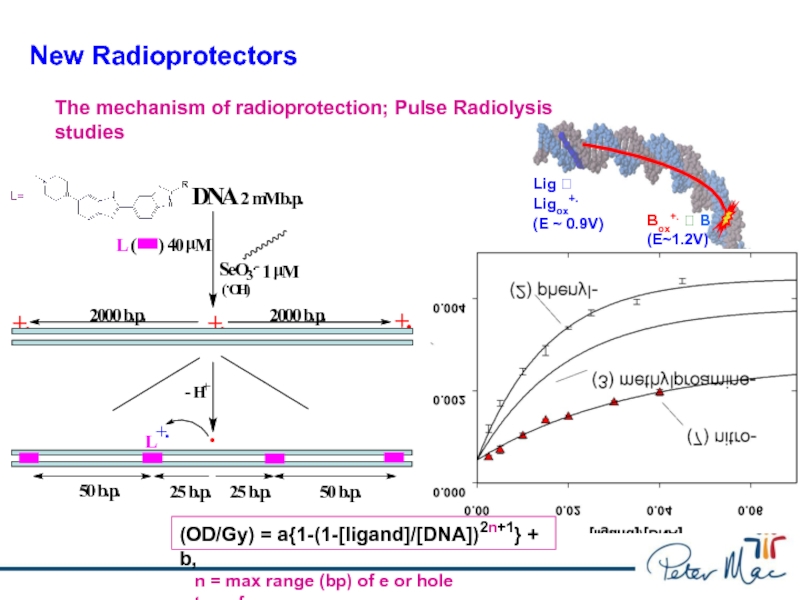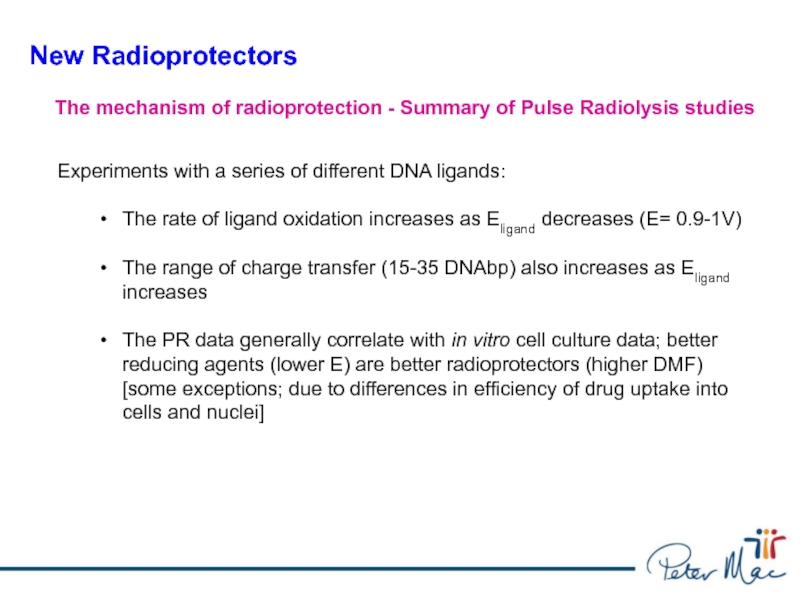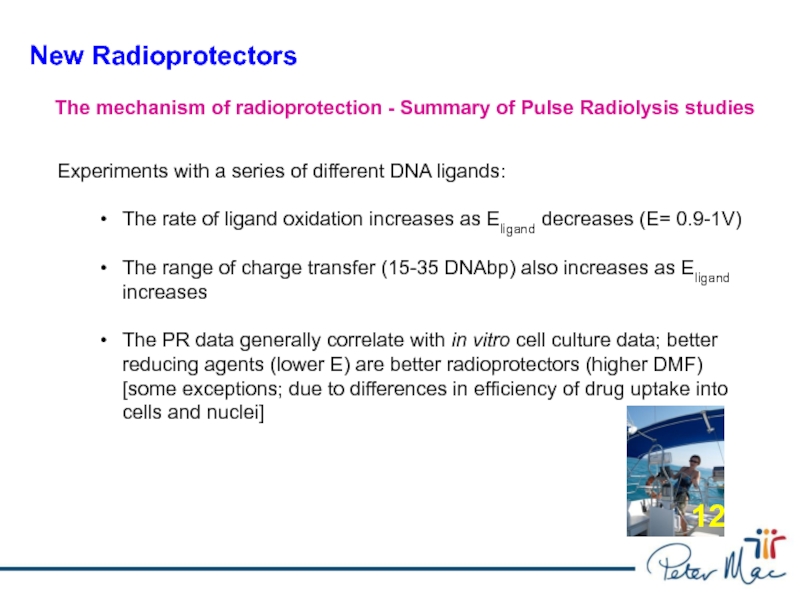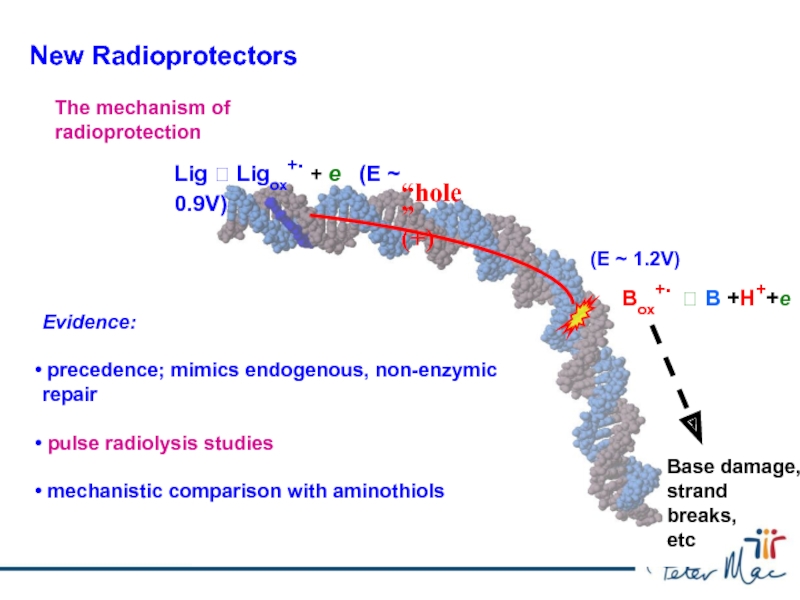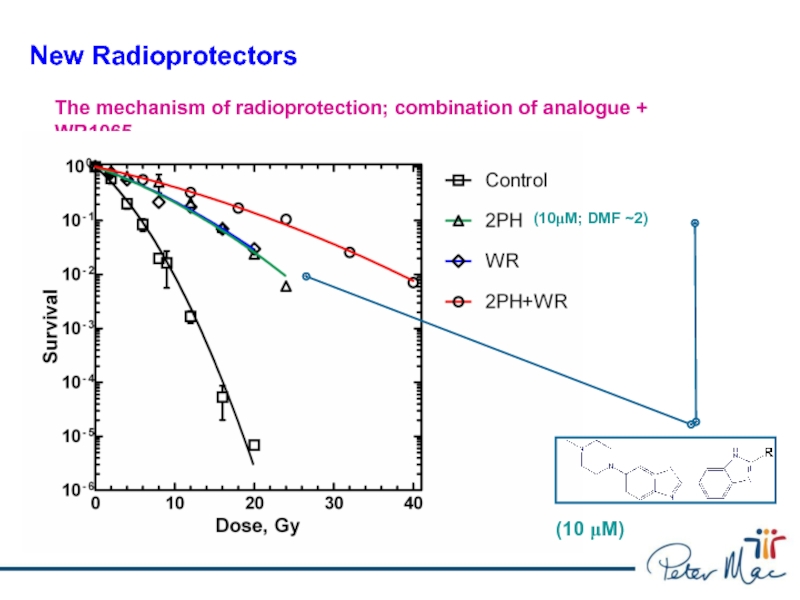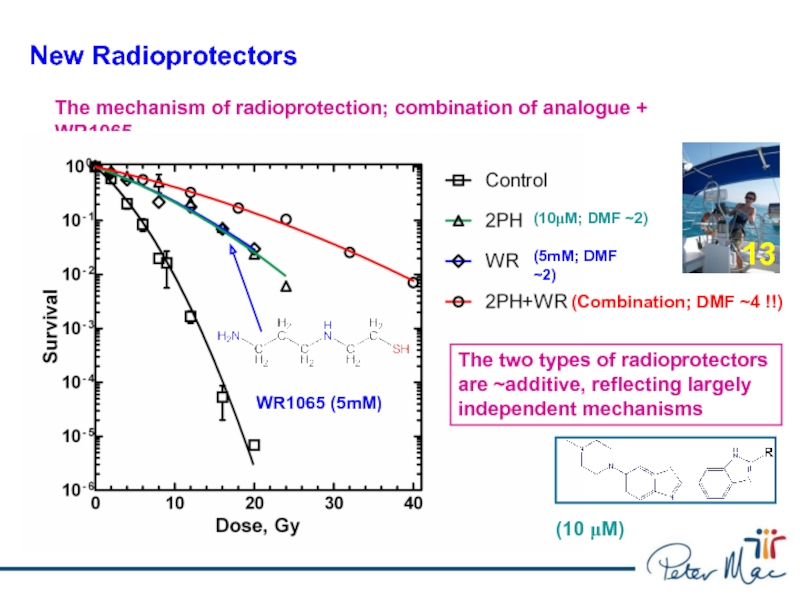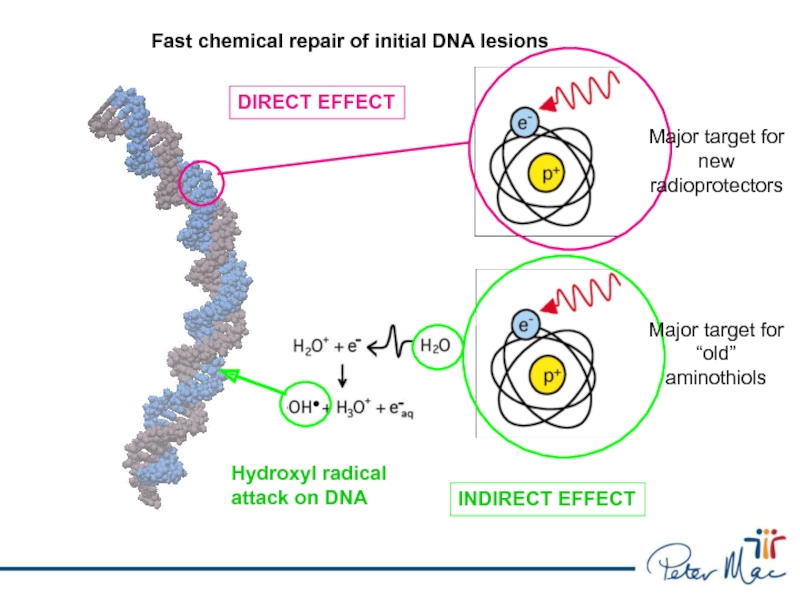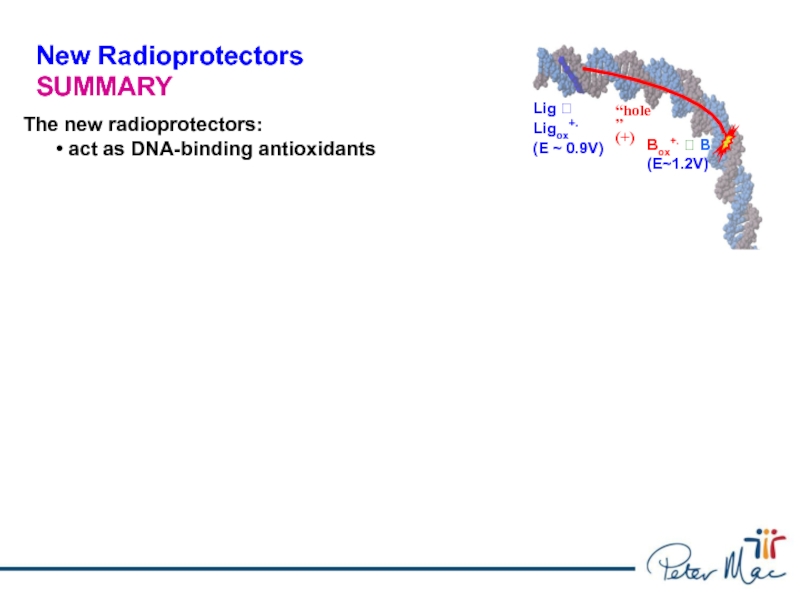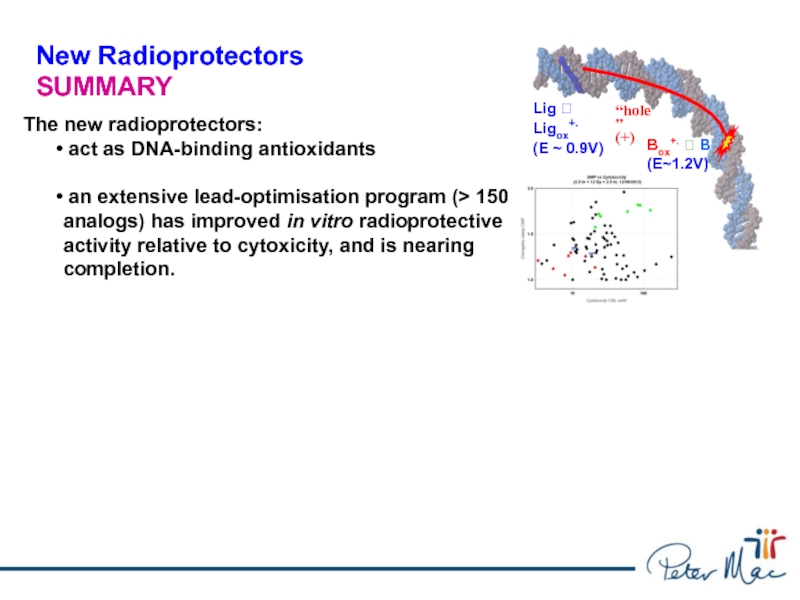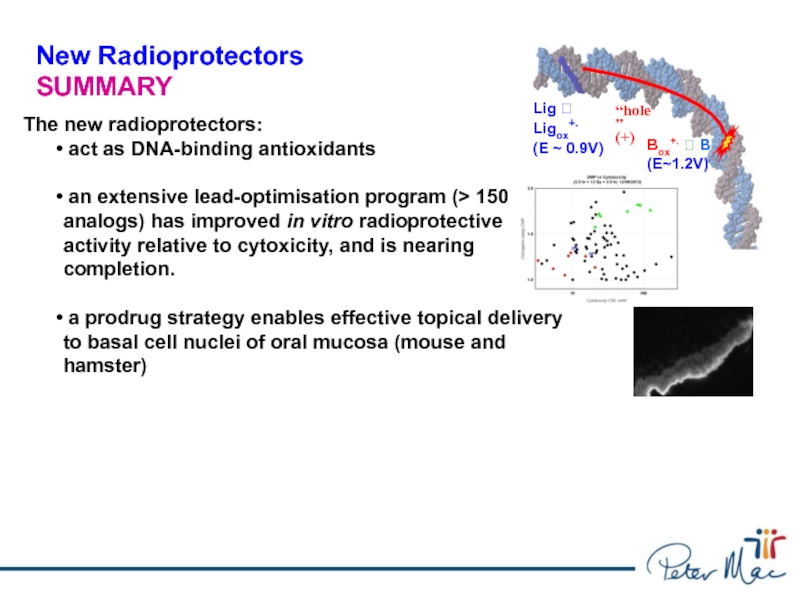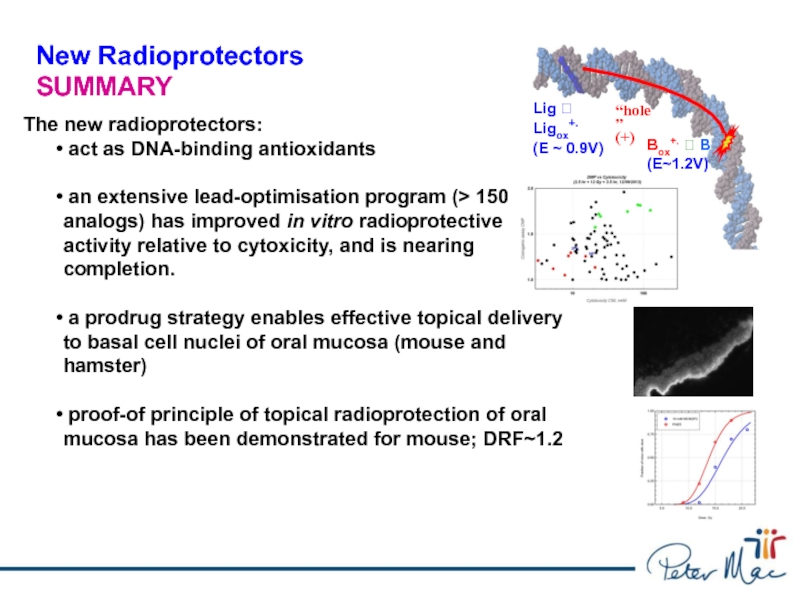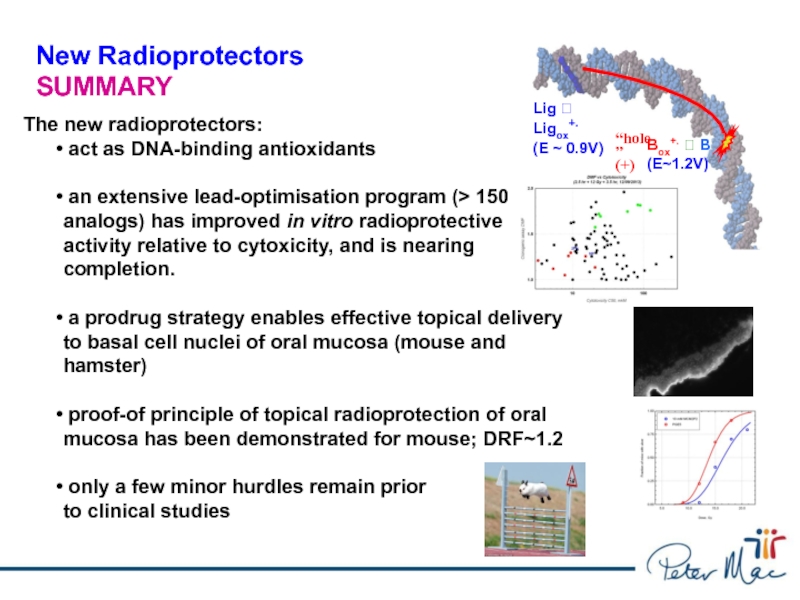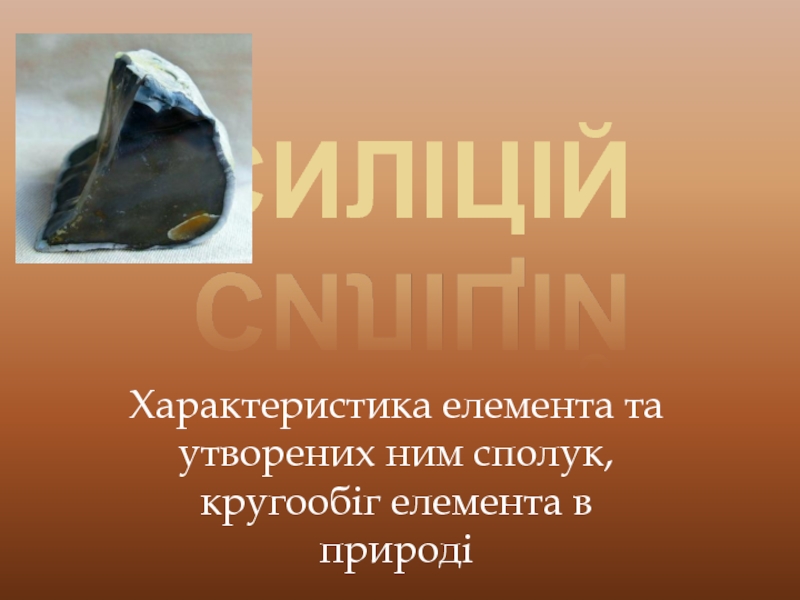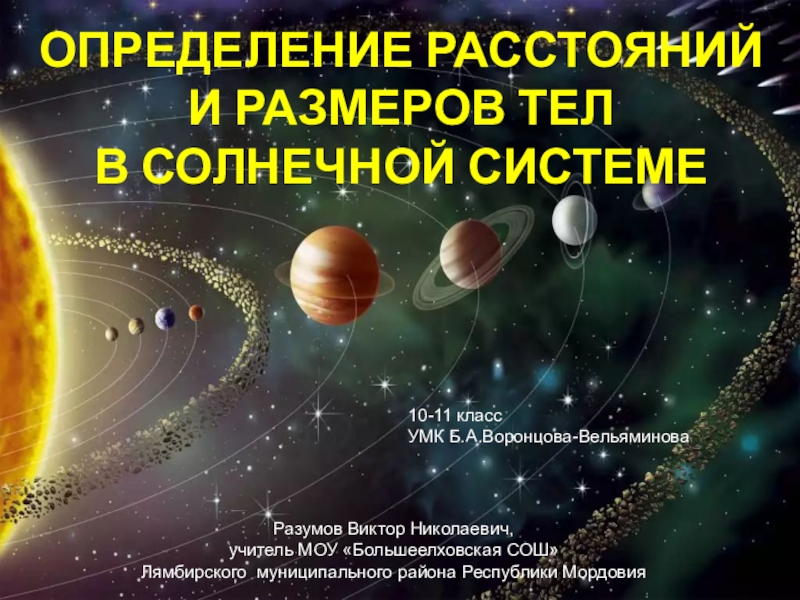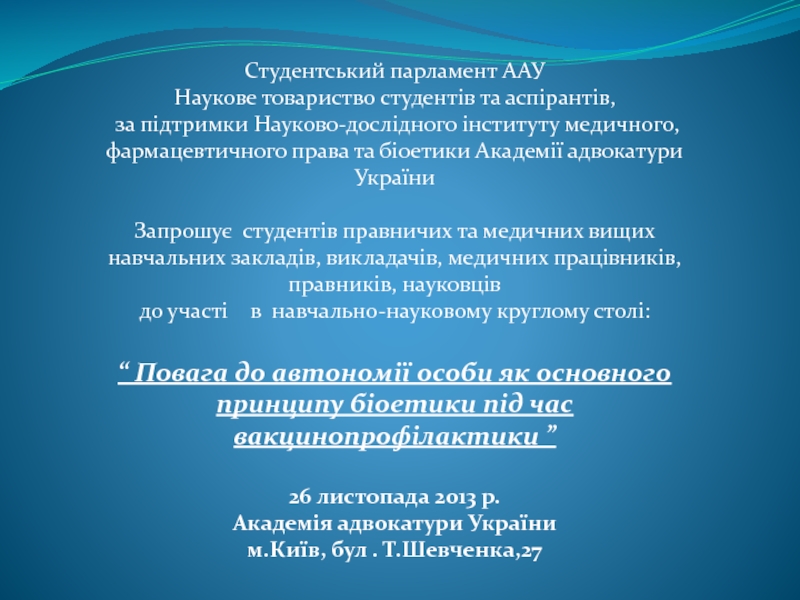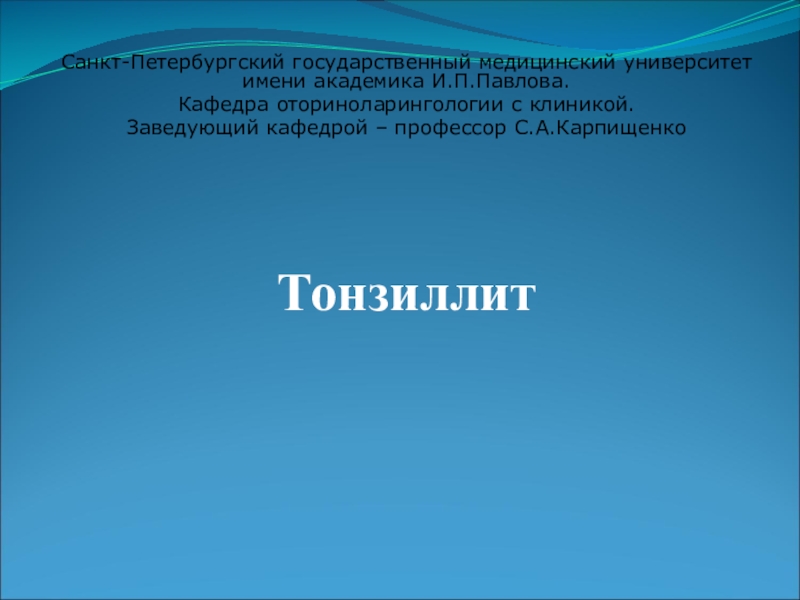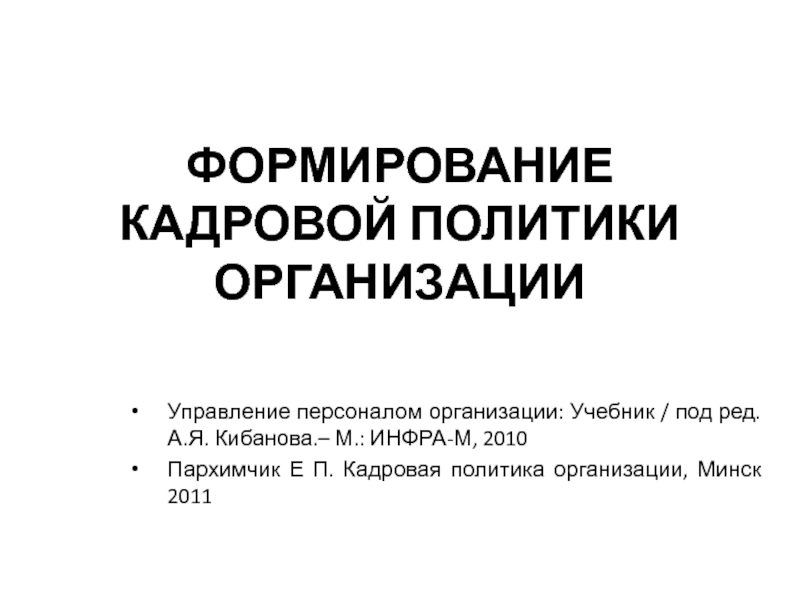Разделы презентаций
- Разное
- Английский язык
- Астрономия
- Алгебра
- Биология
- География
- Геометрия
- Детские презентации
- Информатика
- История
- Литература
- Математика
- Медицина
- Менеджмент
- Музыка
- МХК
- Немецкий язык
- ОБЖ
- Обществознание
- Окружающий мир
- Педагогика
- Русский язык
- Технология
- Физика
- Философия
- Химия
- Шаблоны, картинки для презентаций
- Экология
- Экономика
- Юриспруденция
ФЕДЕРАЛЬНОЕ ГОСУДАРСТВЕННОЕ БЮДЖЕТНОЕ УЧРЕЖДЕНИЕ МЕДИЦИНСКИЙ РАДИОЛОГИЧЕСКИЙ
Содержание
- 1. ФЕДЕРАЛЬНОЕ ГОСУДАРСТВЕННОЕ БЮДЖЕТНОЕ УЧРЕЖДЕНИЕ МЕДИЦИНСКИЙ РАДИОЛОГИЧЕСКИЙ
- 2. Radioprotectors – a clinical perspectiveThe clinical problem of normal tissue damage associated with cancer radiotherapyOral mucositisdermatitis
- 3. …………….Similarly: oro-pharyngeal mucosa (head and neck
- 4. …………….Similarly: oro-pharyngeal mucosa (head and neck
- 5. …………….Similarly: oro-pharyngeal mucosa (head and neck
- 6. Radioprotectors – a clinical perspectiveSkin reactions were
- 7. Radioprotectors – a clinical perspectiveSkin reactions were
- 8. Seminars in Oncology, Vol 10; No. 1,
- 9. Intrarectal Amifostine During External Beam Radiation Therapy
- 10. New DNA-binding radioprotectorsOld radioprotectors1950s>4000 compounds synthesised at Walter Reed Army Institute in USA
- 11. New DNA-binding radioprotectorsOld radioprotectors1950s>4000 compounds synthesised at Walter Reed Army Institute in USA2
- 12. New DNA-binding radioprotectorsOld radioprotectors
- 13. New DNA-binding radioprotectorsOld radioprotectors
- 14. New DNA-binding radioprotectorsOld radioprotectors
- 15. New DNA-binding radioprotectorsOld radioprotectorsDecreasing radioprotective efficacy(Zeng et al)
- 16. New DNA-binding radioprotectorsOld radioprotectorsDecreasing radioprotective efficacy(Zeng et al)Corresponds to decreasing DNA affinity(modest;electrostatic)
- 17. New DNA-binding radioprotectorsOld radioprotectorsDecreasing radioprotective efficacy(Zeng et
- 18. Mechanism of radioprotection by aminothiols
- 19. Mechanism of radioprotection by aminothiolsAminothiols scavange hydroxyl radicals!
- 20. OH• radical(Direct ionisation)DNACOO•anoxicbreakage“Fixed” damage (breaks)repairPSH aminothiol (radioprotector)PS•SummaryLess
- 21. Scavenging of hydroxyl radicalsRepair of DNA radicalsDepletion
- 22. Scavenging of hydroxyl radicalsRepair of DNA radicalsDepletion
- 23. OH• radical(Direct ionisation)DNACOO•anoxicbreakage“Fixed” damage (breaks)repairPSH aminothiol (radioprotector)PS•SummaryLess
- 24. Mechanism of radioprotection by aminothiolsRepair by aminothiols?
- 25. Scavenging of hydroxyl radicalsRepair of DNA radicalsDepletion
- 26. New DNA-binding radioprotectors“Hoechst” DNA ligands Bind in
- 27. New DNA-binding radioprotectors“Hoechst” DNA ligands Fluorescent; intensity
- 28. New DNA-binding radioprotectors“Hoechst” DNA ligands Hoechst 33342
- 29. New DNA-binding radioprotectors“Hoechst” DNA ligands Both Hoechst
- 30. New DNA-binding radioprotectors“Hoechst” DNA ligands V79 cells
- 31. New DNA-binding radioprotectorsLead optimisation I (“minor”)
- 32. New DNA-binding radioprotectorsLead optimisation I (“minor”)
- 33. ~8GyNew DNA-binding radioprotectorsLead optimisation I (“minor”)
- 34. ~8GyNew DNA-binding radioprotectorsLead optimisation I (“minor”)
- 35. ~8GyNew DNA-binding radioprotectorsLead optimisation I (“minor”) Methylproamine concentration in cell culture medium is only 30mM!
- 36. 10mM methylproamine~23~10DMF ~ 23/10DMF > 2 New DNA-binding radioprotectors
- 37. 10mM methylproamine~23~10DMF ~ 23/10DMF > 2 4mM
- 38. 10mM methylproamine~23~10DMF ~ 23/10DMF > 2 4mM
- 39. Human keratinocytesradioprotectioncytotoxicityNew DNA-binding radioprotectors
- 40. Human keratinocytesradioprotectioncytotoxicityHurdle #1 - cytotoxicityNew RadioprotectorsImprove drug design to reduce cytotoxicity
- 41. New analogmethylproamineNew Radioprotectors
- 42. New analogmethylproamineNew RadioprotectorsExtensive lead optimisation supported by Sirtex Medical
- 43. New analogmethylproamineNew RadioprotectorsExtensive lead optimisation supported by Sirtex Medical
- 44. New analogmethylproaminePF ~ 10New RadioprotectorsExtensive lead optimisation supported by Sirtex Medical
- 45. New analogmethylproaminePF ~ 10cytotoxicityNew RadioprotectorsExtensive lead optimisation supported by Sirtex Medical
- 46. New analogmethylproamineExtensive lead optimisation supported by Sirtex
- 47. Lead optimisationNew Radioprotectors
- 48. Lead optimisationPavel LobachevskyNew Radioprotectors
- 49. October 2007Lead optimisationMPNew Radioprotectors“Activity Map”
- 50. Lead optimisationNew RadioprotectorsIncreasing radioprotectionDecreasingcytotoxicity Target zone
- 51. Lead optimisationNew RadioprotectorsIncreasing radioprotectionDecreasingcytotoxicity
- 52. Lead optimisationNew RadioprotectorsIncreasing radioprotectionDecreasingcytotoxicity
- 53. Lead optimisationNew RadioprotectorsIncreasing radioprotectionDecreasingcytotoxicity
- 54. Lead optimisationNew RadioprotectorsIncreasing radioprotectionDecreasingcytotoxicity
- 55. Lead optimisationNew RadioprotectorsIncreasing radioprotectionDecreasingcytotoxicity
- 56. Lead optimisationNew RadioprotectorsIncreasing radioprotectionDecreasingcytotoxicity
- 57. Lead optimisationNew RadioprotectorsIncreasing radioprotectionDecreasingcytotoxicity
- 58. Lead optimisationNew RadioprotectorsIncreasing radioprotectionDecreasingcytotoxicity
- 59. Lead optimisationNew RadioprotectorsIncreasing radioprotectionDecreasingcytotoxicity
- 60. Lead optimisationNew RadioprotectorsIncreasing radioprotectionDecreasingcytotoxicity
- 61. Lead optimisationNew RadioprotectorsSome new analogs in the
- 62. Lead optimisationNew RadioprotectorsSome new analogs in the
- 63. New RadioprotectorsHurdle #1 Cytotoxicity
- 64. New RadioprotectorsHurdle #2 Topical deliveryTarget for radioprotector
- 65. “Hoechst” DNA ligands New RadioprotectorsHurdle #2 Topical delivery
- 66. “Hoechst” DNA ligands New RadioprotectorsHurdle #2 Topical delivery
- 67. Topical; drug mainly on surface“dry”New Radioprotectorsoral cavitysubmucosaHurdle #2 Topical delivery
- 68. Topical; drug mainly on surface“dry”After adding drug
- 69. Topical drug mainly on surface; despite many
- 70. New RadioprotectorsHurdle #2 Topical delivery
- 71. lipid barrierbasal cellssuprabasal cellsdrug moleculeLipid barrier prevents drug delivery to basal cellsNew RadioprotectorsHurdle #2 Topical delivery
- 72. lipid barrierbasal cellssuprabasal cellsdrug moleculeLipid barrier prevents drug delivery to basal cellsNew RadioprotectorsHurdle #2 Topical delivery
- 73. lipid barrierbasal cellssuprabasal cellsdrug moleculeLipid barrier prevents
- 74. lipid barrierbasal cellssuprabasal cellsdrug moleculeLipid barrier prevents
- 75. lipid barrierbasal cellssuprabasal cellsdrug moleculeLipid barrier prevents
- 76. lipid barrierbasal cellssuprabasal cellsdrug moleculeLipid barrier prevents
- 77. Recent results with prodrug strategy“dry”After adding drug
- 78. lipid barrierbasal cellssuprabasal cellsdrug moleculeLipid barrier prevents
- 79. New RadioprotectorsHurdle #2 Topical delivery
- 80. Hurdle #3 Preclinical proof-of-principle (POP) of
- 81. New RadioprotectorsMouse tongue model (Prof Wolfgang Doerr;
- 82. Dresden model @petermacAndrea Smith and Theresa HoltNew Radioprotectors
- 83. Слайд 83
- 84. Слайд 84
- 85. 18 Gy in 241 seconds!
- 86. Слайд 86
- 87. Dresden – tongue ulcerNew Radioprotectors
- 88. Dresden – tongue ulcerNew Radioprotectors
- 89. New Radioprotectors10mM prodrug Vehicle-only
- 90. Vehicle-only ED50 = 13.8Gy ±
- 91. Vehicle-only ED50 = 13.8Gy ±
- 92. Vehicle-only ED50 = 13.8Gy ±
- 93. Vehicle-only ED50 = 13.8Gy ±
- 94. Soreness ± erythemaErythema, ulcers; patient can
- 95. Soreness ± erythemaErythema, ulcers; patient can
- 96. Vehicle-only ED50 = 13.8Gy ±
- 97. Preclinical steps remaining: evaluate the last few-several
- 98. Preclinical steps remaining: evaluate the last few-several
- 99. New RadioprotectorsThe mechanism of radioprotection
- 100. Box+. B +H++e eNew RadioprotectorsThe mechanism
- 101. Box+. B +H++e Lig Ligox+.
- 102. Box+. B +H++e Lig Ligox+.
- 103. Box+. B +H++e Lig Ligox+.
- 104. Box+. B +H++e Lig Ligox+.
- 105. Fast chemical repair of initial DNA lesions
- 106. G++Fast chemical repair of initial DNA lesions
- 107. G+deprotonation
- 108. G+DNAssbdeprotonationElectron and protontransfer TyrG and Tyr-(ie
- 109. G+DNAssbTyr GElectron and proton transfer Fast
- 110. G+DNAssbTyr GElectron and proton transfer Fast
- 111. (amino acid content per nucleosome) (33)(nil)(4)Fast chemical
- 112. Fast chemical repair of initial DNA lesionsLee et al (Milligan) Rad Res 177, 2012
- 113. Fast chemical repair of initial DNA lesions
- 114. Fast chemical repair of initial DNA lesions10
- 115. Jeggo and Lavin Int. J. Radiat. Biol.
- 116. Box+. B +H++e Lig Ligox+.
- 117. Pulse Radiolysis
- 118. Pulse Radiolysis
- 119. Pulse Radiolysis
- 120. Pulse Radiolysis
- 121. Pulse Radiolysis
- 122. Pulse Radiolysis
- 123. New RadioprotectorsThe mechanism of radioprotection; Pulse Radiolysis
- 124. New RadioprotectorsThe mechanism of radioprotection; Pulse Radiolysis studiesSeO42- + eaq SeO3.-(2M tertBuOH; 200nsec)
- 125. New RadioprotectorsThe mechanism of radioprotection; Pulse Radiolysis studiesSeO42- + eaq SeO3.-(2M tertBuOH; 200nsec)11
- 126. New RadioprotectorsThe mechanism of radioprotection; Pulse Radiolysis studiesSeO42- + eaq SeO3.-(2M tertBuOH; 200nsec)
- 127. New RadioprotectorsThe mechanism of radioprotection; Pulse Radiolysis studies(OD/Gy) = a{1-(1-[ligand]/[DNA])2n+1} + b,
- 128. New RadioprotectorsThe mechanism of radioprotection; Pulse Radiolysis
- 129. New RadioprotectorsThe mechanism of radioprotection - Summary
- 130. New RadioprotectorsThe mechanism of radioprotection - Summary
- 131. Box+. B +H++e Lig Ligox+.
- 132. Box+. B +H++e Lig Ligox+.
- 133. New RadioprotectorsThe mechanism of radioprotection; combination of analogue + WR1065(10mM; DMF ~2)(10 mM)
- 134. New RadioprotectorsThe mechanism of radioprotection; combination of analogue + WR1065(10mM; DMF ~2)(5mM; DMF ~2)WR1065 (5mM)
- 135. New RadioprotectorsThe mechanism of radioprotection; combination of
- 136. New RadioprotectorsThe mechanism of radioprotection; combination of
- 137. New RadioprotectorsThe mechanism of radioprotection; combination of
- 138. Fast chemical repair of initial DNA lesionsMajor target for new radioprotectorsMajor target for “old” aminothiols
- 139. New RadioprotectorsSUMMARYThe new radioprotectors: act as DNA-binding antioxidants“hole”(+)
- 140. New RadioprotectorsSUMMARYThe new radioprotectors: act as DNA-binding
- 141. New RadioprotectorsSUMMARYThe new radioprotectors: act as DNA-binding
- 142. New RadioprotectorsSUMMARYThe new radioprotectors: act as DNA-binding
- 143. New RadioprotectorsSUMMARY“hole”(+)The new radioprotectors: act as DNA-binding
- 144. New RadioprotectorsSUMMARY“hole”(+)The new radioprotectors: act as DNA-binding
- 145. Why was an Australian radiobiologist visiting Prof
- 146. Скачать презентанцию
Слайды и текст этой презентации
Слайд 1ФЕДЕРАЛЬНОЕ ГОСУДАРСТВЕННОЕ
БЮДЖЕТНОЕ УЧРЕЖДЕНИЕ
МЕДИЦИНСКИЙ РАДИОЛОГИЧЕСКИЙ НАУЧНЫЙ ЦЕНТР
МИНЗДРАВА РОССИИ
Radiomodifiers: Oxygen/Hypoxia; Radioprotectors
Roger
Martin
Слайд 2Radioprotectors – a clinical perspective
The clinical problem of normal tissue
damage associated with cancer radiotherapy
Oral mucositis
dermatitis
Слайд 3 …………….Similarly:
oro-pharyngeal mucosa (head and neck cancer)
rectal
mucosa (prostate, cervix)
oesophageal mucosa (lung)
small bowel
mucosa (various) bladder (eg cervix)
lung (breast, TBI)
skin, hair follicles (various)
Radioprotectors – a clinical perspective
Слайд 4 …………….Similarly:
oro-pharyngeal mucosa (head and neck cancer)
rectal
mucosa (prostate, cervix)
oesophageal mucosa (lung)
small bowel
mucosa (various) bladder (eg cervix)
lung (breast, TBI)
skin, hair follicles (various)
Radioprotectors – a clinical perspective
Problem normal tissues in cancer RT, that are accessible to topical delivery
→ topical radioprotection
Слайд 5 …………….Similarly:
oro-pharyngeal mucosa (head and neck cancer)
rectal
mucosa (prostate, cervix)
oesophageal mucosa (lung)
small bowel
mucosa (various) bladder (eg cervix)
lung (breast, TBI)
skin, hair follicles (various)
Radioprotectors – a clinical perspective
Problem normal tissues in cancer RT, that are accessible to topical delivery
→ topical radioprotection
1
Слайд 6Radioprotectors – a clinical perspective
Skin reactions were a big problem
in the earlier RT era, with 250, 500 KV X-rays
Слайд 7Radioprotectors – a clinical perspective
Skin reactions were a big problem
in the earlier RT era, with 250, 500 KV X-rays
Слайд 8Seminars in Oncology, Vol 10; No. 1, Suppl. 1; March
1983
Review of early preclinical and clinical studies:
N-acetylcysteine
cysteamine
Radioprotectors – a clinical
perspectiveСлайд 9Intrarectal Amifostine During External Beam Radiation Therapy for Prostate Cancer
Produces Significant Improvements in Quality of Life Measured by EPIC
ScoreNicole L. Simone, M.D.1, Cynthia Ménard, M.D.2, Benjamin P. Soule, M.D.1, Paul S. Albert,
Ph.D.3, Peter Guion, MS1, Sharon Smith, R.N.1, Denise Godette, C.C.P.R.1, Nancy S. Crouse,
R.N.1, Linda C. Sciuto, R.N.1, Theresa Cooley-Zgela, R.N.1, Kevin Camphausen, M.D.1, C.
Norman Coleman, M.D.1, and Anurag K. Singh, M.D.1
Int J Radiat Oncol Biol Phys. 2008 January 1; 70(1): 90–95
Radioprotectors – a clinical perspective
Слайд 10New DNA-binding radioprotectors
Old radioprotectors
1950s
>4000 compounds synthesised
at Walter Reed Army
Institute in USA
Слайд 11New DNA-binding radioprotectors
Old radioprotectors
1950s
>4000 compounds synthesised
at Walter Reed Army
Institute in USA
2
Слайд 15New DNA-binding radioprotectors
Old radioprotectors
Decreasing radioprotective efficacy
(Zeng et al)
Слайд 16New DNA-binding radioprotectors
Old radioprotectors
Decreasing radioprotective efficacy
(Zeng et al)
Corresponds to decreasing
DNA affinity
(modest;
electrostatic)
Слайд 17New DNA-binding radioprotectors
Old radioprotectors
Decreasing radioprotective efficacy
(Zeng et al)
Corresponds to decreasing
DNA affinity
(modest;
electrostatic)
Hence deliberately target radioprotectors to DNA!
Слайд 20OH• radical
(Direct ionisation)
DNA
COO•
anoxic
breakage
“Fixed” damage (breaks)
repair
PSH
aminothiol (radioprotector)
PS•
Summary
Less Damage
More Damage
oxygen
thiols
Mechanism of
radioprotection by aminothiols
Thiols scavange OH• radicals
O2 competes with DNA-C• for
PSH (and endogenous thiols)Слайд 21Scavenging of hydroxyl radicals
Repair of DNA radicals
Depletion of oxygen (extent
of protection much less for hypoxic cells)
Mechanism of radioprotection by
aminothiolsСлайд 22Scavenging of hydroxyl radicals
Repair of DNA radicals
Depletion of oxygen (extent
of protection much less for hypoxic cells)
Mechanism of radioprotection by
aminothiolsСлайд 23OH• radical
(Direct ionisation)
DNA
COO•
anoxic
breakage
“Fixed” damage (breaks)
repair
PSH
aminothiol (radioprotector)
PS•
Summary
Less Damage
More Damage
oxygen
thiols
Mechanism of
radioprotection by aminothiols
Thiols scavange OH• radicals
O2 competes with DNA-C• for
PSH (and endogenous thiols)Слайд 25Scavenging of hydroxyl radicals
Repair of DNA radicals
Depletion of oxygen (extent
of protection much less for hypoxic cells)
Mechanism of radioprotection by
aminothiols3
Слайд 26New DNA-binding radioprotectors
“Hoechst” DNA ligands
Bind in the minor groove
of DNA, with high affinity (Kd ~100nM)
Слайд 27New DNA-binding radioprotectors
“Hoechst” DNA ligands
Fluorescent; intensity increases upon binding
to DNA:
stain nuclei (chromosome aberrations; FACS – cell cycle
analysis)Слайд 28New DNA-binding radioprotectors
“Hoechst” DNA ligands
Hoechst 33342 has radioprotective activity
(Smith and Anderson, 1984; Young and Hill, 1989)
Fluorescent; intensity increases
upon binding to DNA:stain nuclei (chromosome aberrations; FACS – cell cycle analysis)
Слайд 29New DNA-binding radioprotectors
“Hoechst” DNA ligands
Both Hoechst 33342 and Hoechst
33258 protect isolated DNA from radiation-induced strand breakage (Martin et
al 1990)Слайд 35~8Gy
New DNA-binding radioprotectors
Lead optimisation I (“minor”)
Methylproamine
concentration in cell
culture medium is only 30mM!
Слайд 3710mM methylproamine
~23
~10
DMF ~ 23/10
DMF > 2
4mM WR1065 required for
DMF ~ 2
Methylproamine is more than 100- times more potent
than amifostineNew DNA-binding radioprotectors
Слайд 3810mM methylproamine
~23
~10
DMF ~ 23/10
DMF > 2
4mM WR1065 required for
DMF ~ 2
Methylproamine is more than 100- times more potent
than amifostineNew DNA-binding radioprotectors
4
Слайд 40Human keratinocytes
radioprotection
cytotoxicity
Hurdle #1 - cytotoxicity
New Radioprotectors
Improve drug design to reduce
cytotoxicity
Слайд 42New analog
methylproamine
New Radioprotectors
Extensive lead optimisation supported by Sirtex Medical
Слайд 43New analog
methylproamine
New Radioprotectors
Extensive lead optimisation supported by Sirtex Medical
Слайд 44New analog
methylproamine
PF ~ 10
New Radioprotectors
Extensive lead optimisation supported by Sirtex
Medical
Слайд 45New analog
methylproamine
PF ~ 10
cytotoxicity
New Radioprotectors
Extensive lead optimisation supported by Sirtex
Medical
Слайд 46New analog
methylproamine
Extensive lead optimisation supported by Sirtex Medical
PF ~ 10
cytotoxicity
C50
– drug concentration that reduces clonogenic survival by 50%
New Radioprotectors
Слайд 50Lead optimisation
New Radioprotectors
Increasing radioprotection
Decreasing
cytotoxicity
Target zone
Слайд 61Lead optimisation
New Radioprotectors
Some new analogs in the “target zone”; ie:
less cytotoxic than MP, and
improved radioprotective activity
Increasing radioprotection
Decreasing
cytotoxicity
Слайд 62Lead optimisation
New Radioprotectors
Some new analogs in the “target zone”; ie:
less cytotoxic than MP, and
improved radioprotective activity
Increasing radioprotection
Decreasing
cytotoxicity
5
Слайд 64New Radioprotectors
Hurdle #2 Topical delivery
Target for radioprotector delivery is nuclei
of basal cells, which include stem cells
Слайд 67Topical; drug mainly on surface
“dry”
New Radioprotectors
oral cavity
submucosa
Hurdle #2 Topical delivery
Слайд 68Topical; drug mainly on surface
“dry”
After adding drug plus buffer to
section:
Section saturated with drug in solution
New Radioprotectors
oral cavity
submucosa
Hurdle #2 Topical
deliveryPavel Lobachevsky
Слайд 69Topical drug mainly on surface; despite many changes to formulation!
“dry”
After
adding drug plus buffer to section:
Section saturated with drug in
solutionNew Radioprotectors
oral cavity
submucosa
Hurdle #2 Topical delivery
Слайд 71lipid barrier
basal cells
suprabasal cells
drug molecule
Lipid barrier prevents drug delivery to
basal cells
New Radioprotectors
Hurdle #2 Topical delivery
Слайд 72lipid barrier
basal cells
suprabasal cells
drug molecule
Lipid barrier prevents drug delivery to
basal cells
New Radioprotectors
Hurdle #2 Topical delivery
Слайд 73lipid barrier
basal cells
suprabasal cells
drug molecule
Lipid barrier prevents drug delivery to
basal cells
Prodrug strategy
Prodrug molecule
promoiety
Prodrug, with altered properties, penetrates barrier
New Radioprotectors
Hurdle
#2 Topical deliveryСлайд 74lipid barrier
basal cells
suprabasal cells
drug molecule
Lipid barrier prevents drug delivery to
basal cells
Prodrug strategy
Prodrug molecule
promoiety
New Radioprotectors
Prodrug, with altered properties, penetrates barrier
Hurdle
#2 Topical deliveryСлайд 75lipid barrier
basal cells
suprabasal cells
drug molecule
Lipid barrier prevents drug delivery to
basal cells
Prodrug strategy
Prodrug molecule
promoiety
New Radioprotectors
Prodrug, with altered properties, penetrates barrier
Hurdle
#2 Topical deliveryСлайд 76lipid barrier
basal cells
suprabasal cells
drug molecule
Lipid barrier prevents drug delivery to
basal cells
Prodrug strategy
Prodrug molecule
promoiety
New Radioprotectors
Prodrug, with altered properties, penetrates barrier,
andParent drug delivered to basal cell nuclei
Hurdle #2 Topical delivery
Слайд 77Recent results with prodrug strategy
“dry”
After adding drug plus buffer to
section:
Section saturated with drug in solution
New Radioprotectors
Hurdle #2 Topical delivery
Слайд 78lipid barrier
basal cells
suprabasal cells
drug molecule
Lipid barrier prevents drug delivery to
basal cells
Prodrug strategy
Prodrug molecule
promoiety
New Radioprotectors
Prodrug, with altered properties, penetrates barrier,
andParent drug delivered to basal cell nuclei
Hurdle #2 Topical delivery
6
Слайд 80Hurdle #3 Preclinical proof-of-principle (POP) of
Topical radioprotection
Mouse tongue model (Prof Wolfgang Doerr; Dresden)....
New Radioprotectors
Слайд 81New Radioprotectors
Mouse tongue model (Prof Wolfgang Doerr; Dresden)....now set-up at
PeterMac
Hurdle #3 Preclinical (POP) of Topical radioprotection
Слайд 90 Vehicle-only ED50 = 13.8Gy ± 0.31 (St E)
10mM
prodrug ED50 = 16.9 ± 2.7 (St E)
[p=0.0129]
Pavel Lobachevsky
New Radioprotectors
10mM
prodrugVehicle-only
Слайд 91 Vehicle-only ED50 = 13.8Gy ± 0.31 (St E)
10mM
prodrug ED50 = 16.9 ± 2.7 (St E)
Dose Reduction Factor
= 1.22 (16.9/13.8)[p=0.0129]
New Radioprotectors
10mM prodrug
Vehicle-only
Hurdle #3 Preclinical (POP) of Topical radioprotection
Слайд 92 Vehicle-only ED50 = 13.8Gy ± 0.31 (St E)
10mM
prodrug ED50 = 16.9 ± 2.7 (St E)
Dose Reduction Factor
= 1.22 (16.9/13.8)[p=0.0129]
New Radioprotectors
10mM prodrug
Vehicle-only
Hurdle #3 Preclinical (POP) of Topical radioprotection
7
Слайд 93 Vehicle-only ED50 = 13.8Gy ± 0.31 (St E)
10mM
prodrug ED50 = 16.9 ± 2.7 (St E)
Dose Reduction Factor
= 1.22 (16.9/13.8)[p=0.0129]
New Radioprotectors
10mM prodrug
Vehicle-only
BUT is DRF ~ 1.2? Enough?
Слайд 94Soreness
± erythema
Erythema,
ulcers;
patient can
swallow
solid food
Mucositis
to the extent
that alimentation
is not possible
Ulcers
with extensive erythema; patient cannot swallow food
Grade 2
Grade 3
Severe Mucositis
Grade
1Grade 4
New Radioprotectors
Development of a topical radioprotector to ameliorate normal tissue toxicity in RT patients
DRF ~ 1.2
80% of H&N RT patients
(Bellm et al 2000)
Слайд 95Soreness
± erythema
Erythema,
ulcers;
patient can
swallow
solid food
Mucositis
to the extent
that alimentation
is not possible
Ulcers
with extensive erythema; patient cannot swallow food
Grade 2
Grade 3
Severe Mucositis
Grade
1Grade 4
New Radioprotectors
Development of a topical radioprotector to ameliorate normal tissue toxicity in RT patients
DRF ~ 1.2
80% of H&N RT patients
(Bellm et al 2000)
8
Слайд 96 Vehicle-only ED50 = 13.8Gy ± 0.31 (St E)
10mM
prodrug ED50 = 16.9 ± 2.7 (St E)
Dose Reduction Factor
= 1.22 (16.9/13.8)[p=0.0129]
New Radioprotectors
10mM prodrug
Vehicle-only
Слайд 97Preclinical steps remaining:
evaluate the last few-several parent drugs
select
final lead (some toxicology)
confirm pre-clinical POP of topical radioprotection
in fractionation modeldevelop “clinically friendly” topical formulation
New Radioprotectors
Слайд 98Preclinical steps remaining:
evaluate the last few-several parent drugs
select
final lead (some toxicology)
confirm pre-clinical POP of topical radioprotection
in fractionation modeldevelop “clinically friendly” topical formulation
New Radioprotectors
Слайд 100Box+. B +H++e
e
New Radioprotectors
The mechanism of radioprotection
(E ~
1.2V)
Base damage,
strand breaks,
etc
Lig Ligox+. + e
(E ~ 0.9V)Слайд 101Box+. B +H++e
Lig Ligox+. + e
(E ~ 0.9V)
“hole”
(+)
New Radioprotectors
The mechanism of radioprotection
(E ~ 1.2V)
Base damage,
strand breaks,
etc
Слайд 102Box+. B +H++e
Lig Ligox+. + e
(E ~ 0.9V)
“hole”
(+)
New Radioprotectors
The mechanism of radioprotection
(E ~ 1.2V)
Base damage,
strand breaks,
etc
Evidence:
precedence; mimics endogenous, non-enzymic repair
pulse radiolysis studies
mechanistic comparison with aminothiols
9
Слайд 103Box+. B +H++e
Lig Ligox+. + e
(E ~ 0.9V)
“hole”
(+)
New Radioprotectors
The mechanism of radioprotection
(E ~ 1.2V)
Base damage,
strand breaks,
etc
Evidence:
precedence; mimics endogenous, non-enzymic repair
pulse radiolysis studies
mechanistic comparison with aminothiols
Слайд 104Box+. B +H++e
Lig Ligox+. + e
(E ~ 0.9V)
“hole”
(+)
New Radioprotectors
The mechanism of radioprotection
(E ~ 1.2V)
Base damage,
strand breaks,
etc
Evidence:
precedence; mimics endogenous, non-enzymic repair
pulse radiolysis studies
mechanistic comparison with aminothiols
Слайд 108 G+
DNAssb
deprotonation
Electron and proton
transfer
Tyr
G and Tyr-
(ie Repair of DNA)
Tsoi
et al (Milligan) Org Biomol Chem 8, 2010
Слайд 109 G+
DNAssb
Tyr
G
Electron and proton transfer
Fast chemical repair of
initial DNA lesions
Tsoi et al (Milligan) Org Biomol Chem 8,
2010Tyrosine is a radioprotector in model experiments with plasmid DNA
Слайд 110 G+
DNAssb
Tyr
G
Electron and proton transfer
Fast chemical repair of
initial DNA lesions
Tsoi et al (Milligan) Org Biomol Chem 8,
2010Слайд 111(amino acid content per nucleosome)
(33)
(nil)
(4)
Fast chemical repair of initial
DNA lesions
Lee et al (Milligan) Rad Res 177, 2012
Слайд 115Jeggo and Lavin Int. J. Radiat. Biol. 85, 1061. 2009
Fast
(early) chemical repair of initial DNA lesions
Слайд 116Box+. B +H++e
Lig Ligox+. + e
(E ~ 0.9V)
“hole”
(+)
New Radioprotectors
The mechanism of radioprotection
(E ~ 1.2V)
Base damage,
strand breaks,
etc
Evidence:
precedence; mimics endogenous, non-enzymic repair
pulse radiolysis studies
mechanistic comparison with aminothiols
Слайд 123New Radioprotectors
The mechanism of radioprotection; Pulse Radiolysis studies
SeO42- + eaq
SeO3.-
(2M tertBuOH; 200nsec)
Bob Anderson
Univ of Auckland
Слайд 124New Radioprotectors
The mechanism of radioprotection; Pulse Radiolysis studies
SeO42- + eaq
SeO3.-
(2M tertBuOH; 200nsec)
Слайд 125New Radioprotectors
The mechanism of radioprotection; Pulse Radiolysis studies
SeO42- + eaq
SeO3.-
(2M tertBuOH; 200nsec)
11
Слайд 126New Radioprotectors
The mechanism of radioprotection; Pulse Radiolysis studies
SeO42- + eaq
SeO3.-
(2M tertBuOH; 200nsec)
Слайд 127New Radioprotectors
The mechanism of radioprotection; Pulse Radiolysis studies
(OD/Gy) = a{1-(1-[ligand]/[DNA])2n+1}
+ b,
Слайд 128New Radioprotectors
The mechanism of radioprotection; Pulse Radiolysis studies
n = max
range (bp) of e or hole transfer
(OD/Gy) = a{1-(1-[ligand]/[DNA])2n+1} +
b,Слайд 129New Radioprotectors
The mechanism of radioprotection - Summary of Pulse Radiolysis
studies
Experiments with a series of different DNA ligands:
The rate of
ligand oxidation increases as Eligand decreases (E= 0.9-1V)The range of charge transfer (15-35 DNAbp) also increases as Eligand increases
The PR data generally correlate with in vitro cell culture data; better reducing agents (lower E) are better radioprotectors (higher DMF) [some exceptions; due to differences in efficiency of drug uptake into cells and nuclei]
Слайд 130New Radioprotectors
The mechanism of radioprotection - Summary of Pulse Radiolysis
studies
Experiments with a series of different DNA ligands:
The rate of
ligand oxidation increases as Eligand decreases (E= 0.9-1V)The range of charge transfer (15-35 DNAbp) also increases as Eligand increases
The PR data generally correlate with in vitro cell culture data; better reducing agents (lower E) are better radioprotectors (higher DMF) [some exceptions; due to differences in efficiency of drug uptake into cells and nuclei]
12
Слайд 131Box+. B +H++e
Lig Ligox+. + e
(E ~ 0.9V)
“hole”
(+)
New Radioprotectors
The mechanism of radioprotection
(E ~ 1.2V)
Base damage,
strand breaks,
etc
Evidence:
precedence; mimics endogenous, non-enzymic repair
pulse radiolysis studies
mechanistic comparison with aminothiols
Слайд 132Box+. B +H++e
Lig Ligox+. + e
(E ~ 0.9V)
“hole”
(+)
New Radioprotectors
The mechanism of radioprotection
(E ~ 1.2V)
Base damage,
strand breaks,
etc
Evidence:
precedence; mimics endogenous, non-enzymic repair
pulse radiolysis studies
mechanistic comparison with aminothiols
Слайд 133New Radioprotectors
The mechanism of radioprotection; combination of analogue + WR1065
(10mM;
DMF ~2)
(10 mM)
Слайд 134New Radioprotectors
The mechanism of radioprotection; combination of analogue + WR1065
(10mM;
DMF ~2)
(5mM; DMF ~2)
WR1065 (5mM)
Слайд 135New Radioprotectors
The mechanism of radioprotection; combination of analogue + WR1065
(10mM;
DMF ~2)
(5mM; DMF ~2)
WR1065 (5mM)
(Combination; DMF ~4 !!)
(10 mM)
Слайд 136New Radioprotectors
The mechanism of radioprotection; combination of analogue + WR1065
(10mM;
DMF ~2)
(5mM; DMF ~2)
WR1065 (5mM)
(Combination; DMF ~4 !!)
The two types
of radioprotectors are ~additive, reflecting largely independent mechanisms(10 mM)
Слайд 137New Radioprotectors
The mechanism of radioprotection; combination of analogue + WR1065
(10mM;
DMF ~2)
(5mM; DMF ~2)
WR1065 (5mM)
(Combination; DMF ~4 !!)
The two types
of radioprotectors are ~additive, reflecting largely independent mechanisms(10 mM)
13
Слайд 138Fast chemical repair of initial DNA lesions
Major target for new
radioprotectors
Major target for “old” aminothiols
Слайд 139New Radioprotectors
SUMMARY
The new radioprotectors:
act as DNA-binding antioxidants
“hole”
(+)
Слайд 140New Radioprotectors
SUMMARY
The new radioprotectors:
act as DNA-binding antioxidants
an
extensive lead-optimisation program (> 150 analogs) has improved in vitro
radioprotective activity relative to cytoxicity, and is nearing completion.“hole”
(+)
Слайд 141New Radioprotectors
SUMMARY
The new radioprotectors:
act as DNA-binding antioxidants
an
extensive lead-optimisation program (> 150 analogs) has improved in vitro
radioprotective activity relative to cytoxicity, and is nearing completion.a prodrug strategy enables effective topical delivery to basal cell nuclei of oral mucosa (mouse and hamster)
“hole”
(+)
Слайд 142New Radioprotectors
SUMMARY
The new radioprotectors:
act as DNA-binding antioxidants
an
extensive lead-optimisation program (> 150 analogs) has improved in vitro
radioprotective activity relative to cytoxicity, and is nearing completion.a prodrug strategy enables effective topical delivery to basal cell nuclei of oral mucosa (mouse and hamster)
proof-of principle of topical radioprotection of oral mucosa has been demonstrated for mouse; DRF~1.2
“hole”
(+)
Слайд 143New Radioprotectors
SUMMARY
“hole”
(+)
The new radioprotectors:
act as DNA-binding antioxidants
an
extensive lead-optimisation program (> 150 analogs) has improved in vitro
radioprotective activity relative to cytoxicity, and is nearing completion.a prodrug strategy enables effective topical delivery to basal cell nuclei of oral mucosa (mouse and hamster)
proof-of principle of topical radioprotection of oral mucosa has been demonstrated for mouse; DRF~1.2
only a few minor hurdles remain prior
to clinical studies
13
Слайд 144New Radioprotectors
SUMMARY
“hole”
(+)
The new radioprotectors:
act as DNA-binding antioxidants
an
extensive lead-optimisation program (> 150 analogs) has improved in vitro
radioprotective activity relative to cytoxicity, and is nearing completion.a prodrug strategy enables effective topical delivery to basal cell nuclei of oral mucosa (mouse and hamster)
proof-of principle of topical radioprotection of oral mucosa has been demonstrated for mouse; DRF~1.2
only a few minor hurdles remain prior
to clinical studies
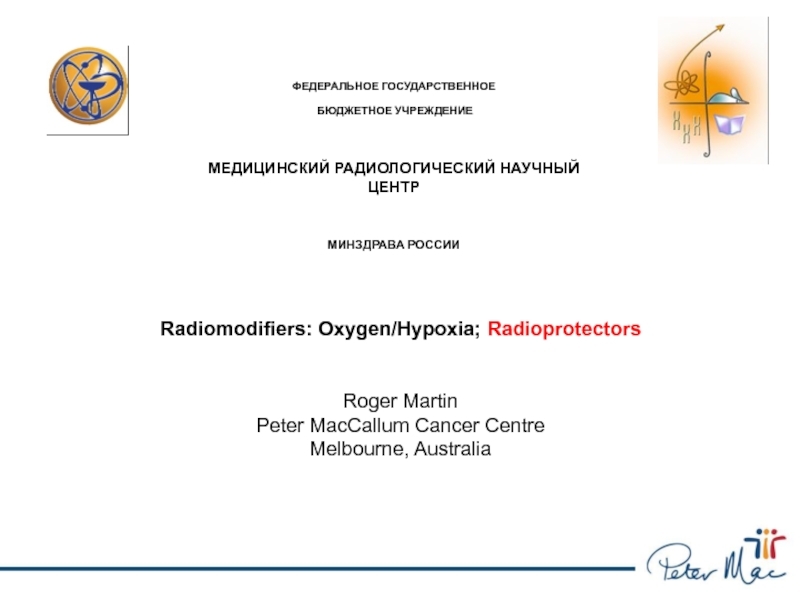


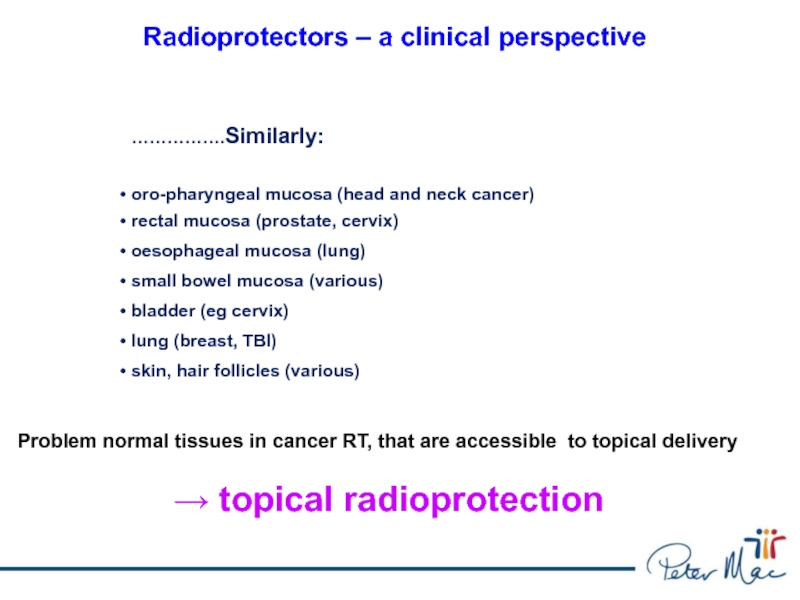

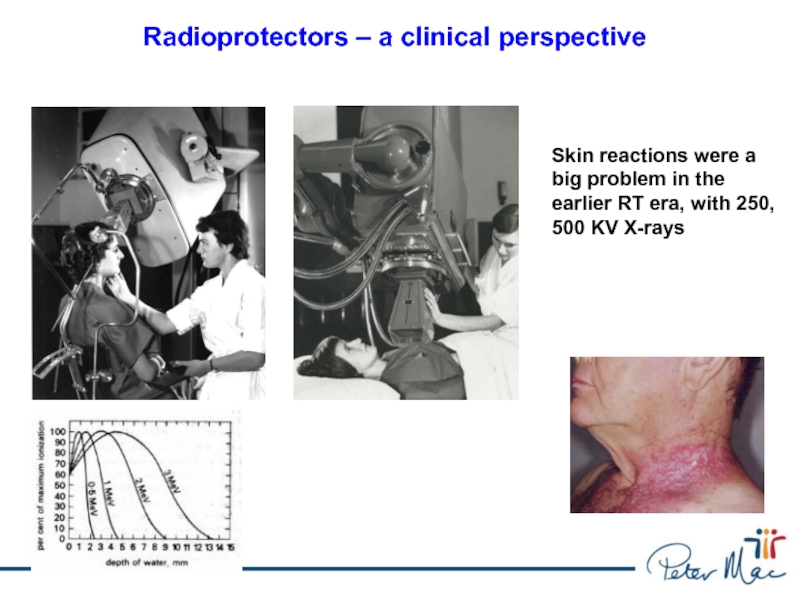
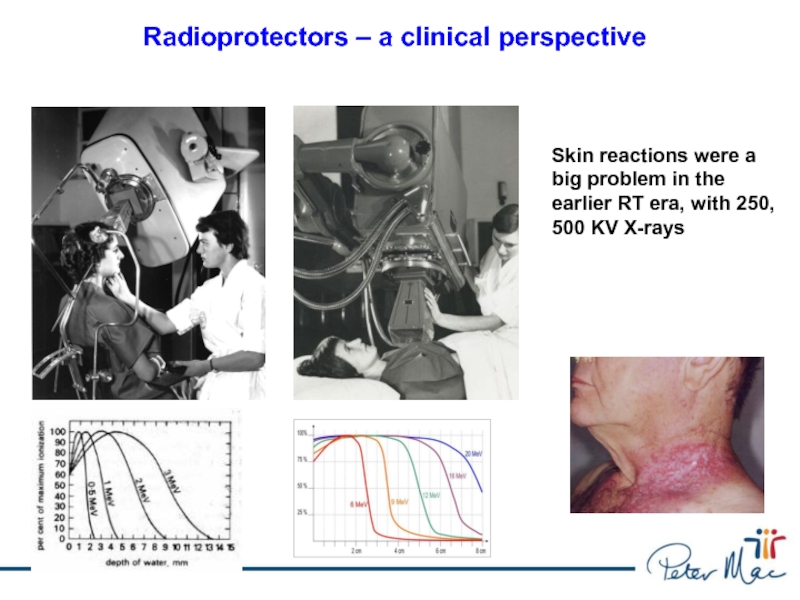
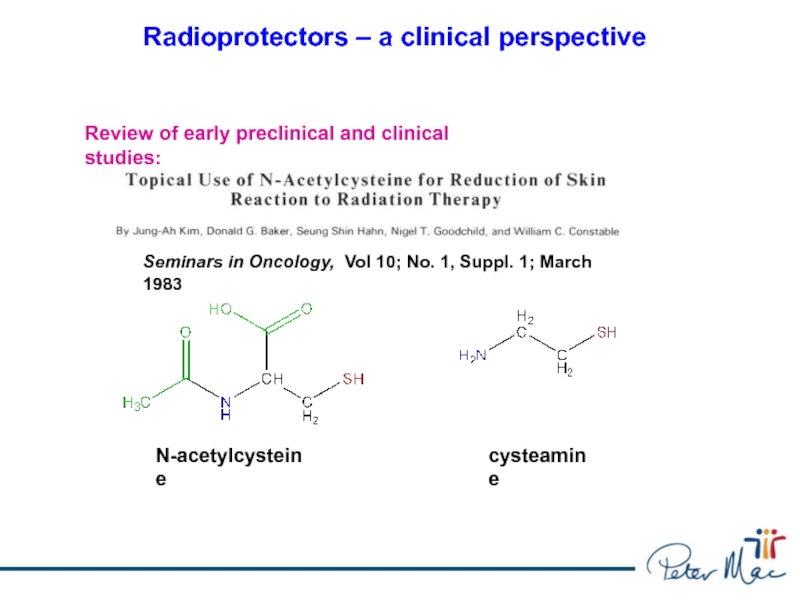
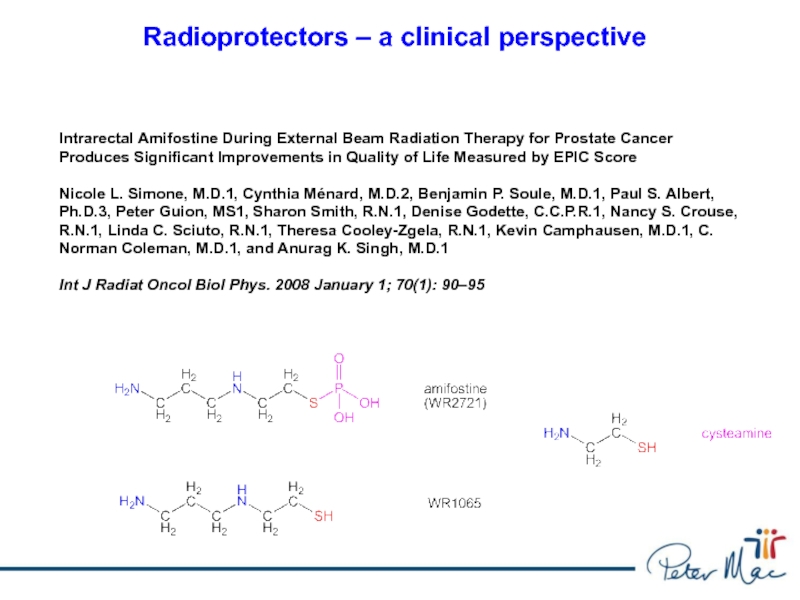
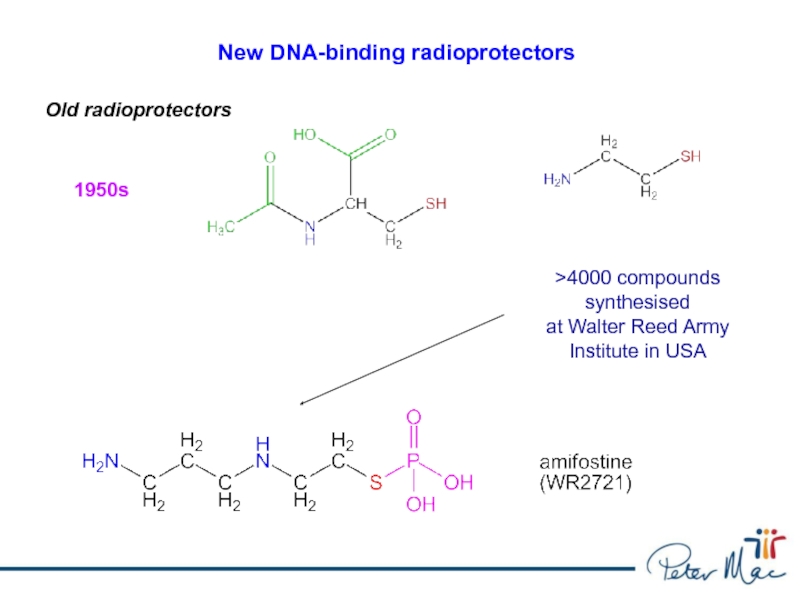
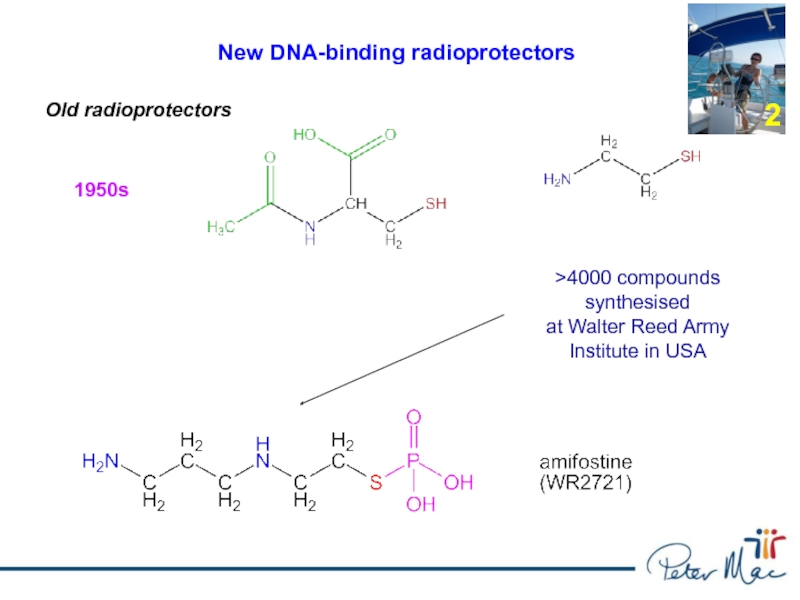

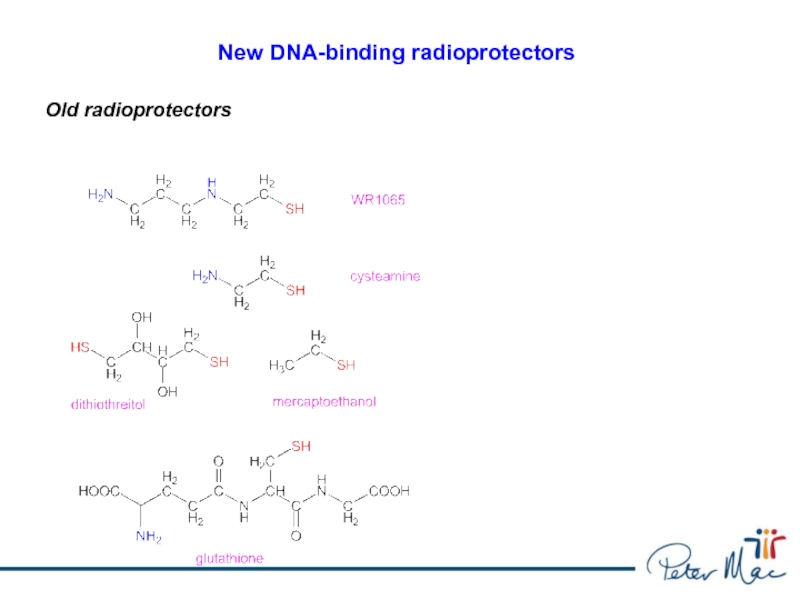
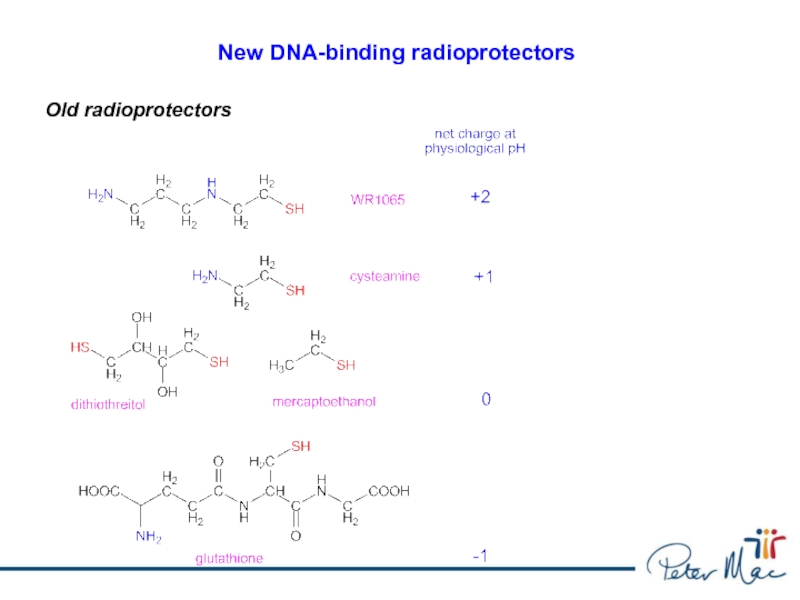



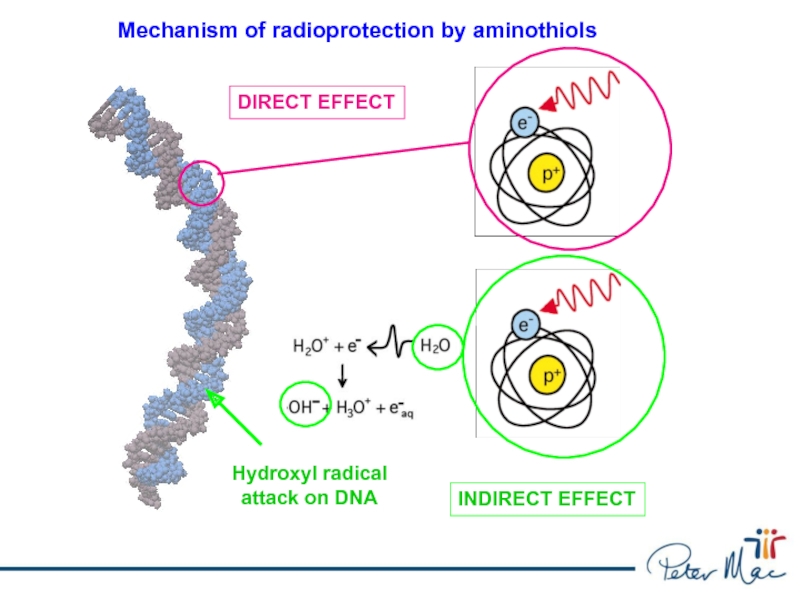
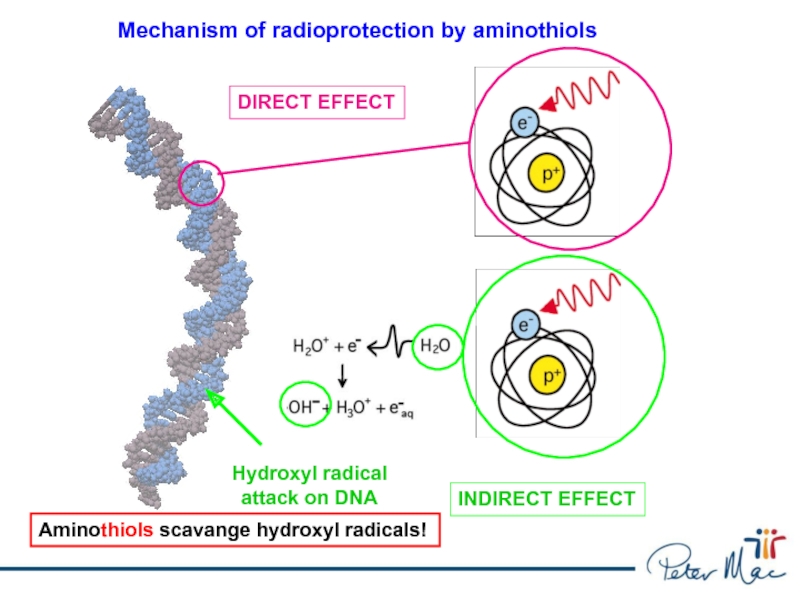

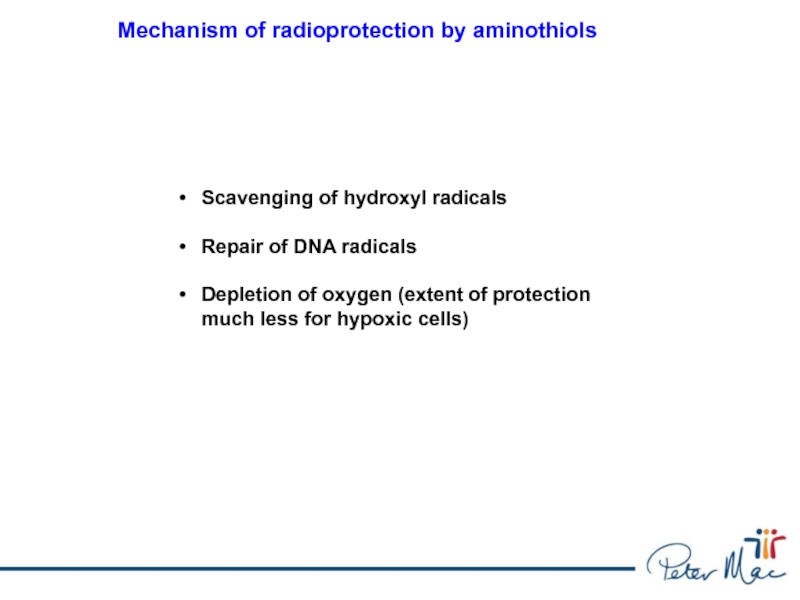
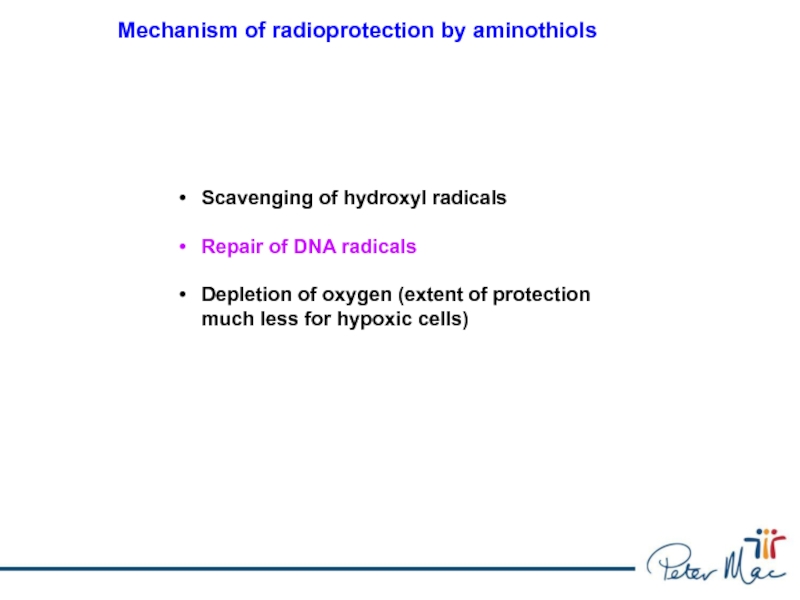
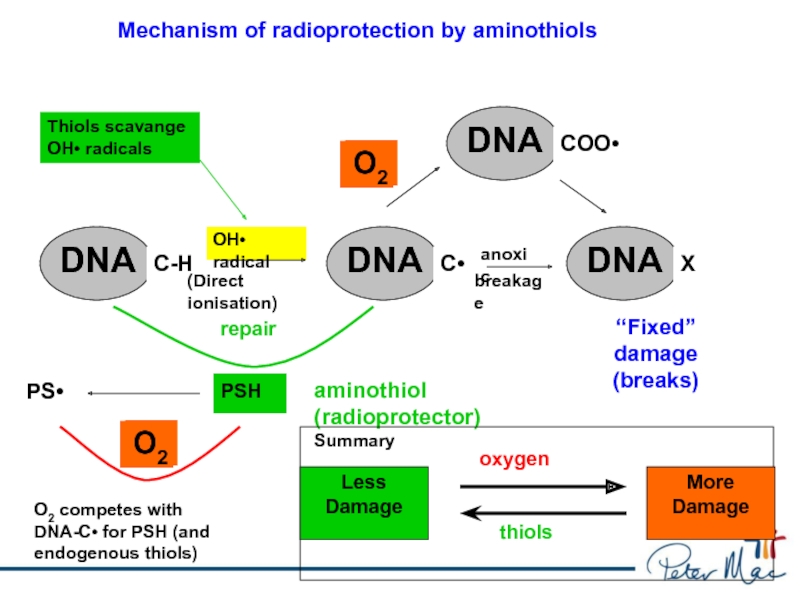
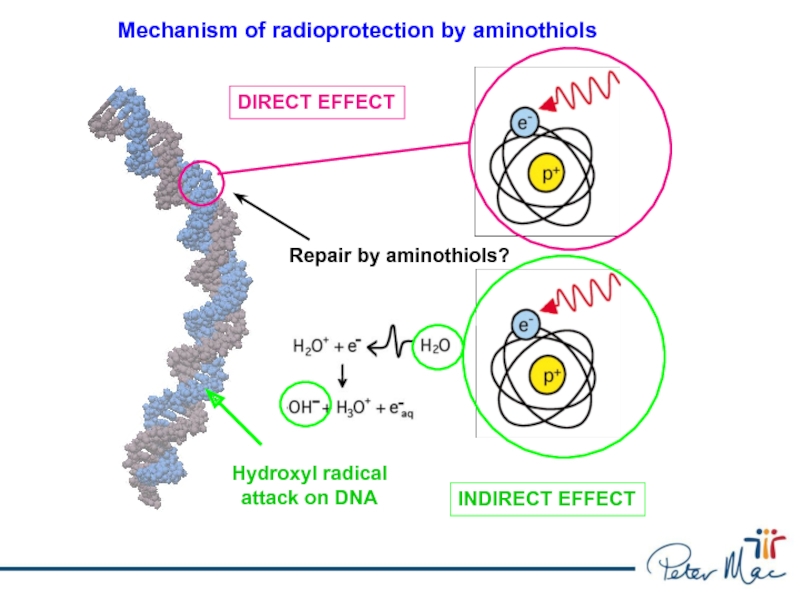
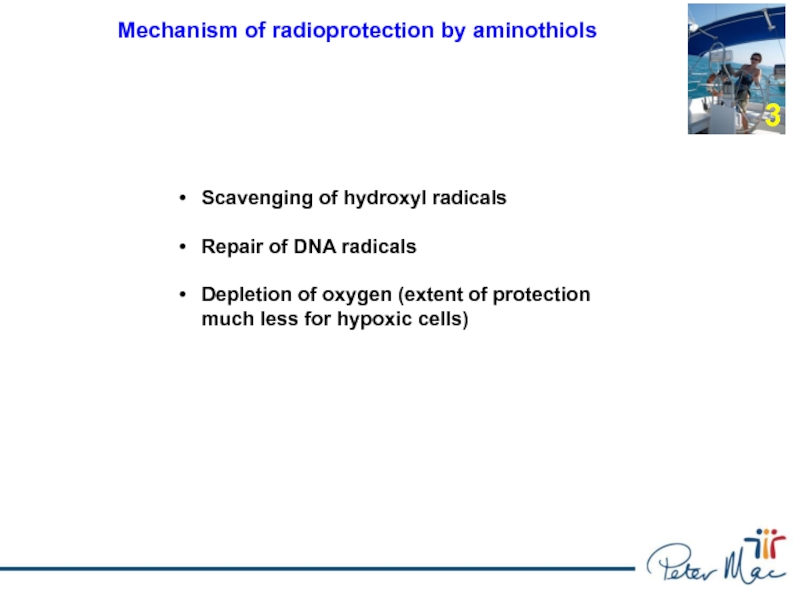

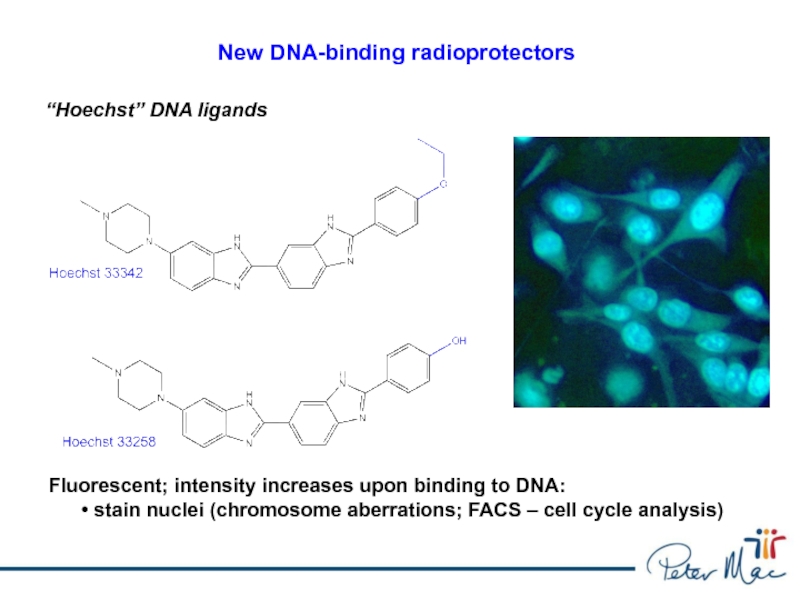


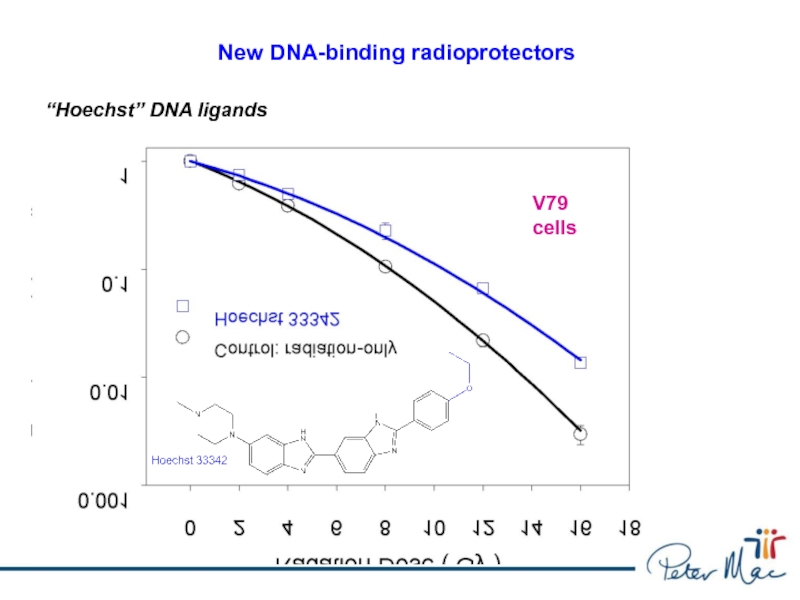
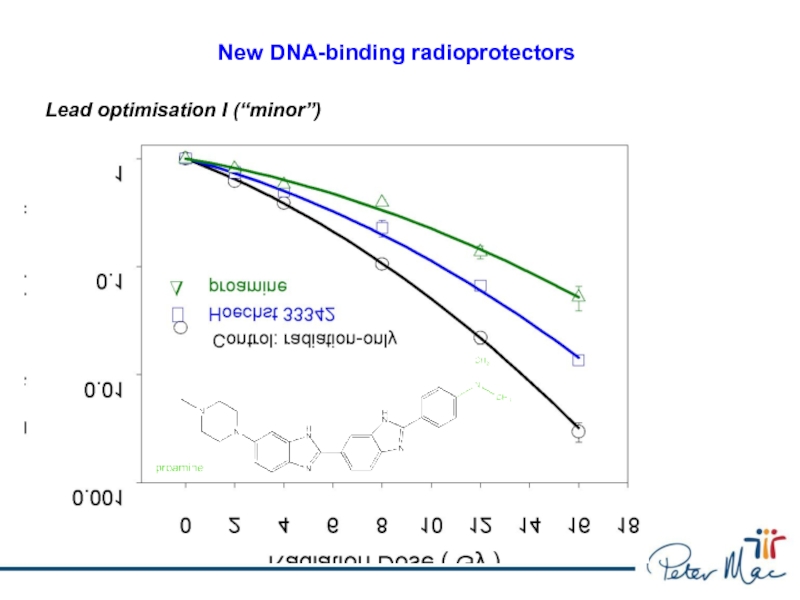
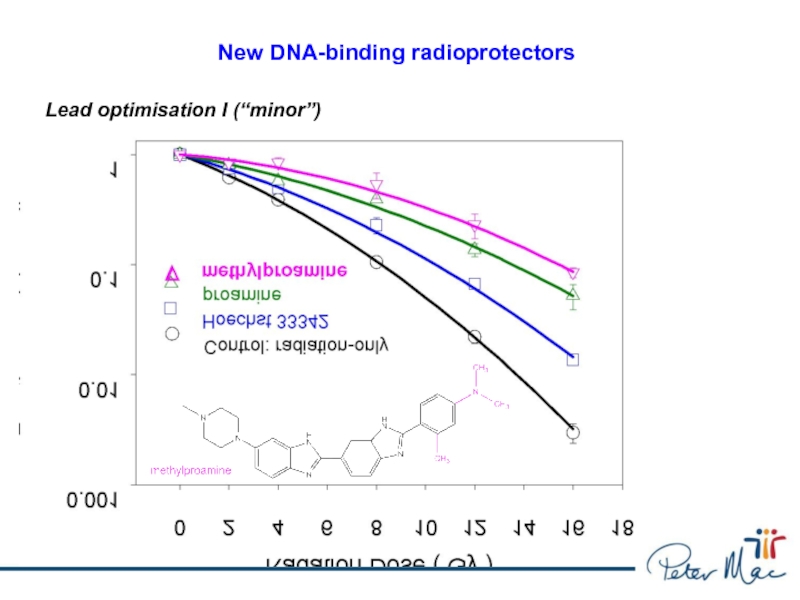
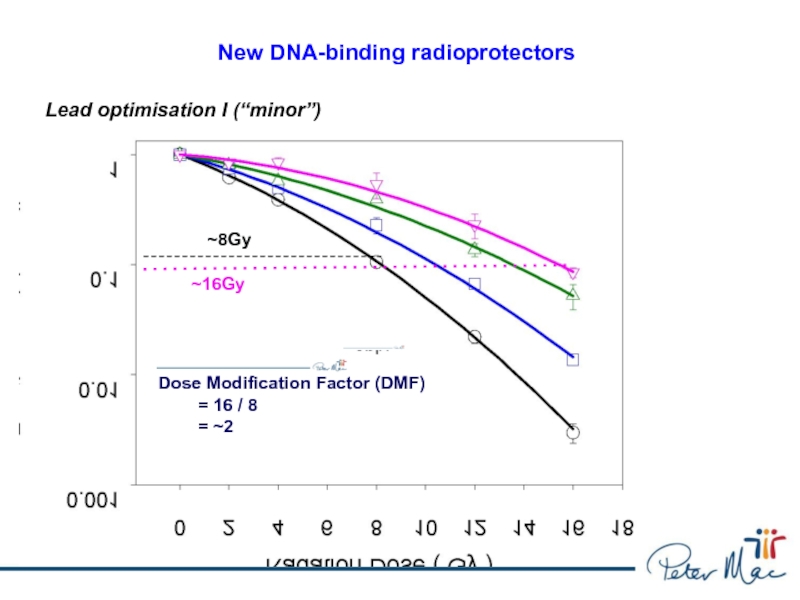
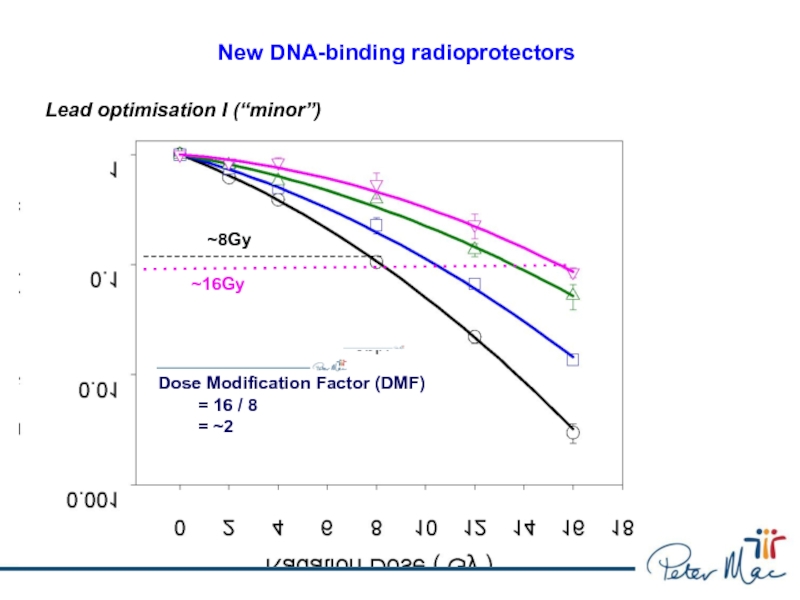


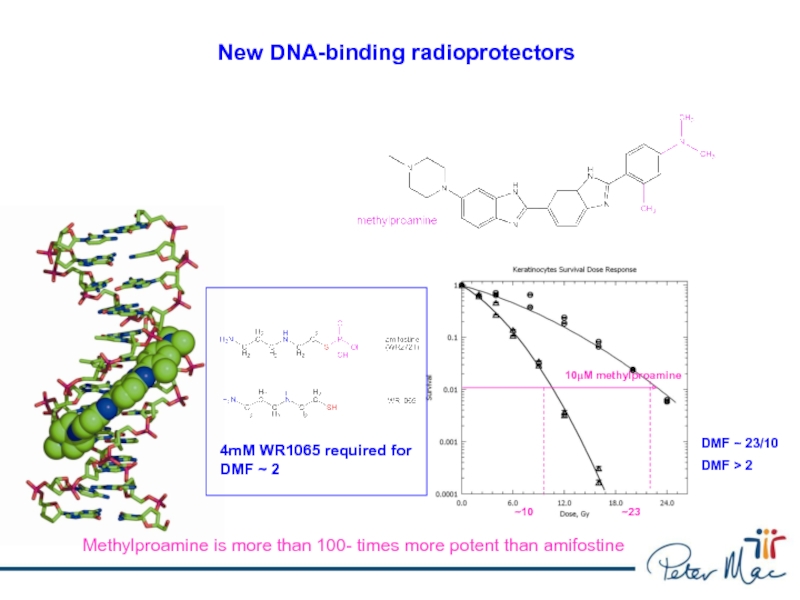
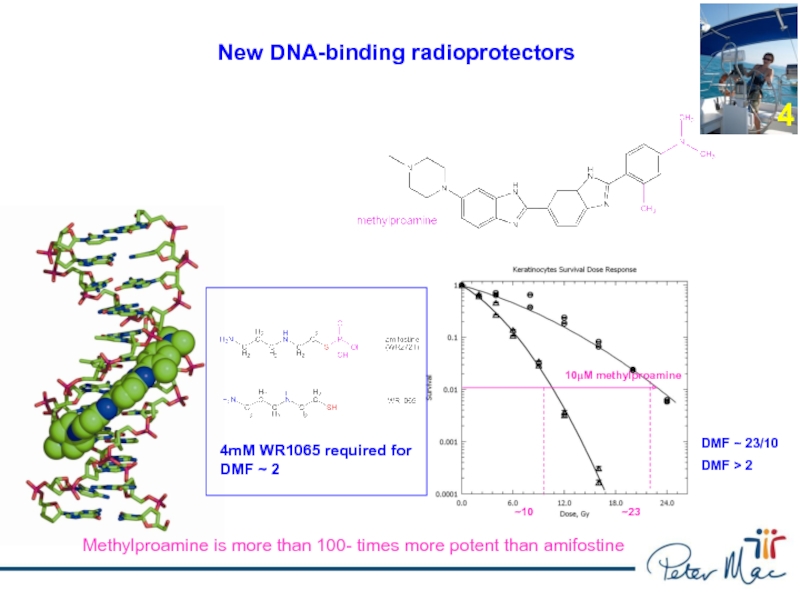
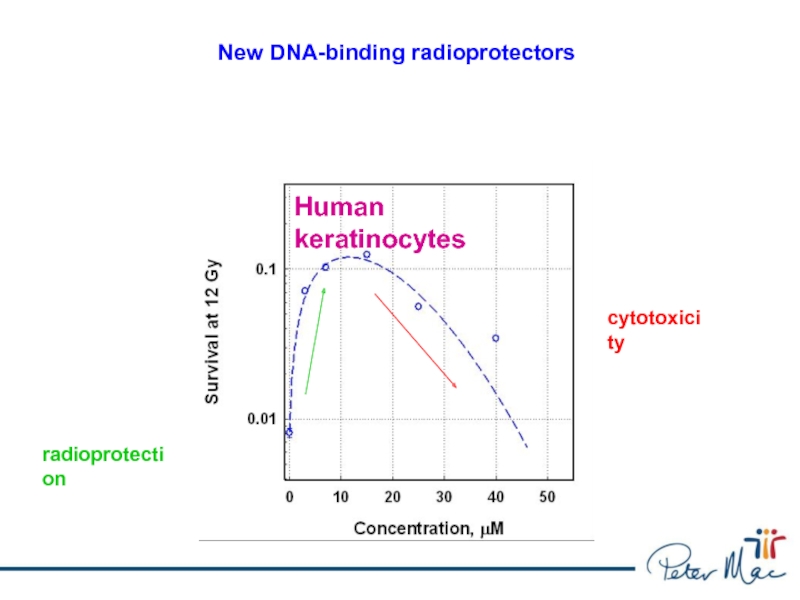

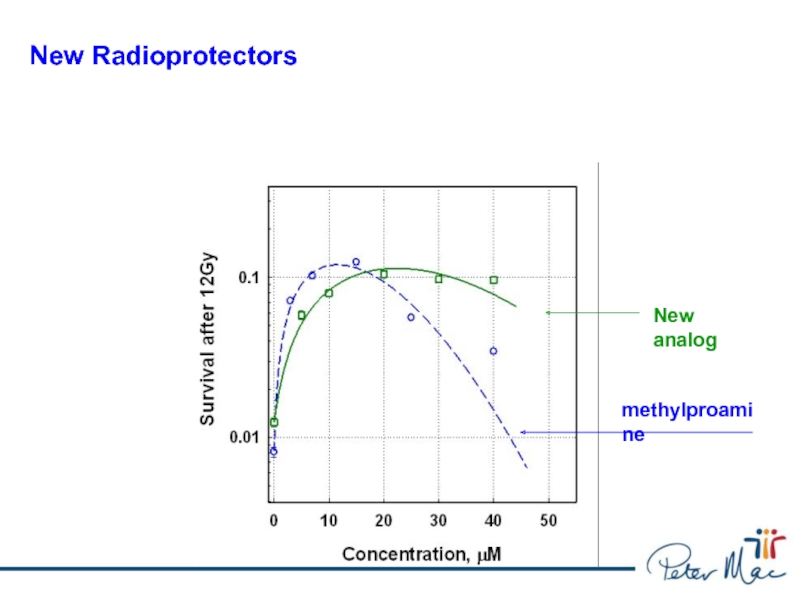
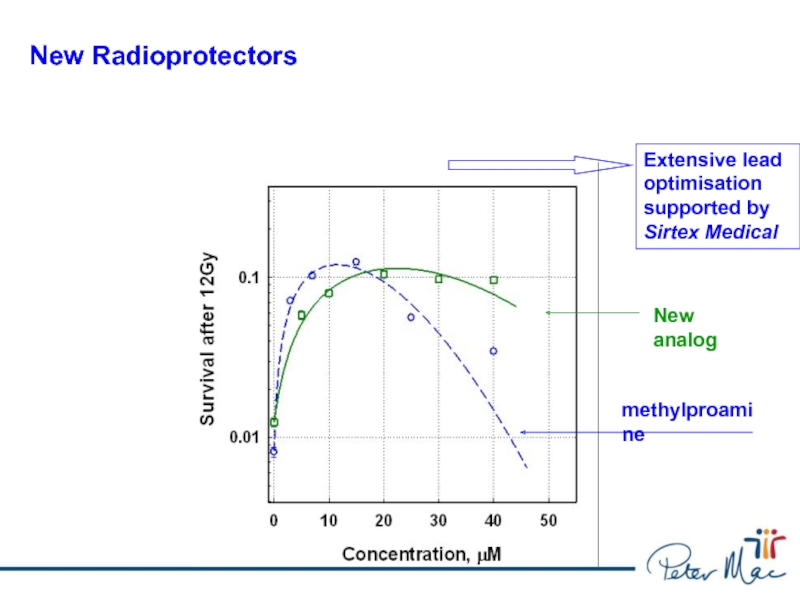
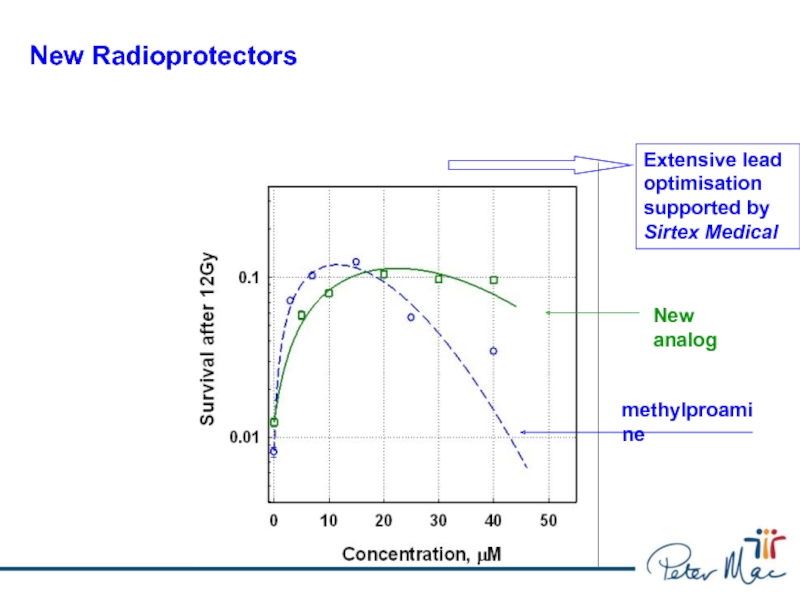
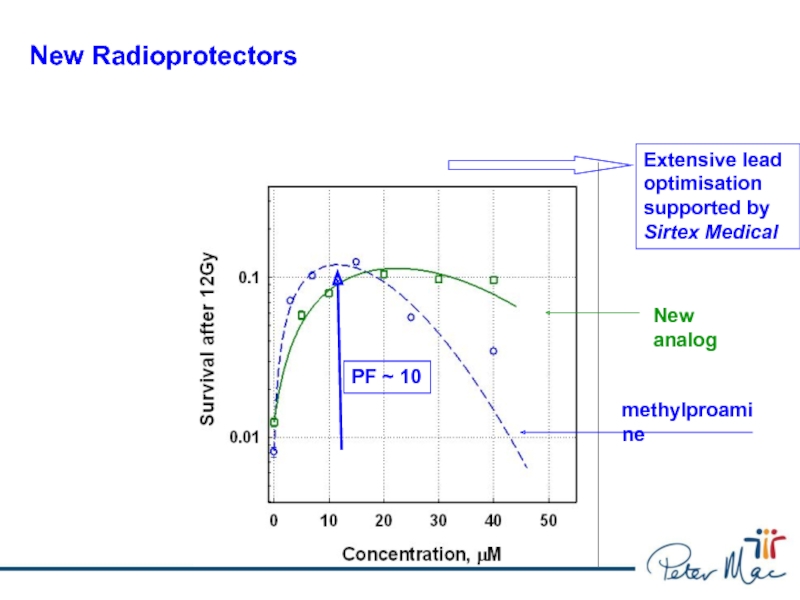

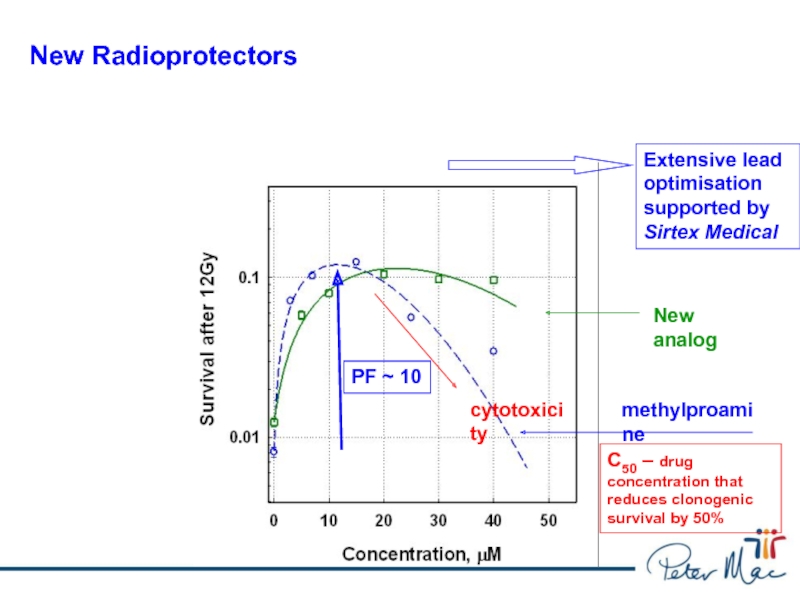





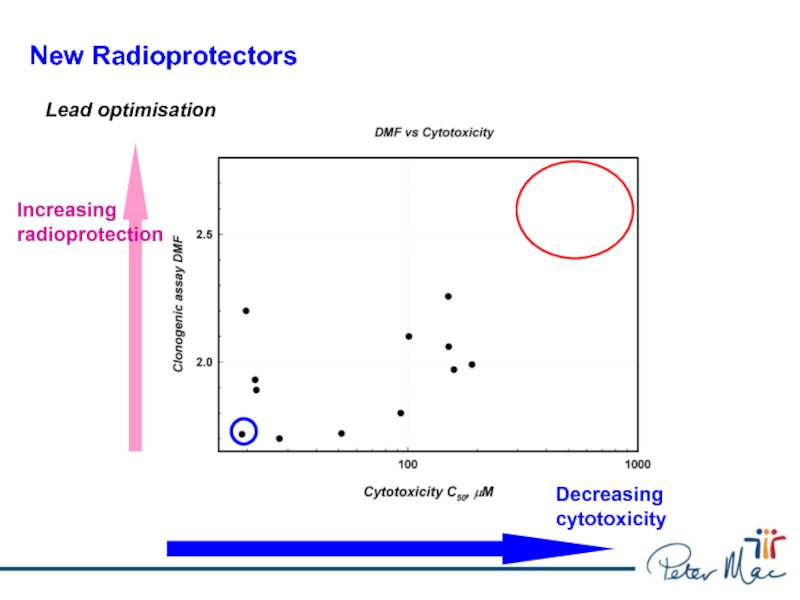
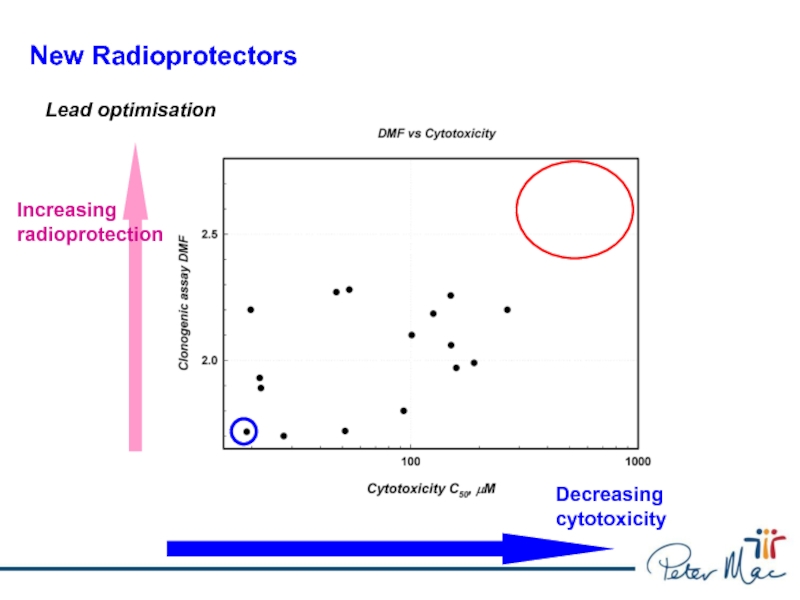

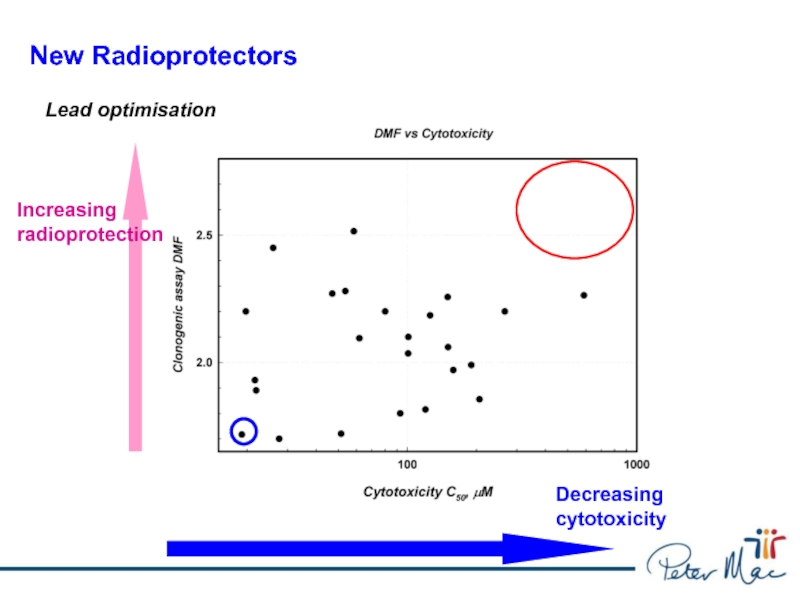


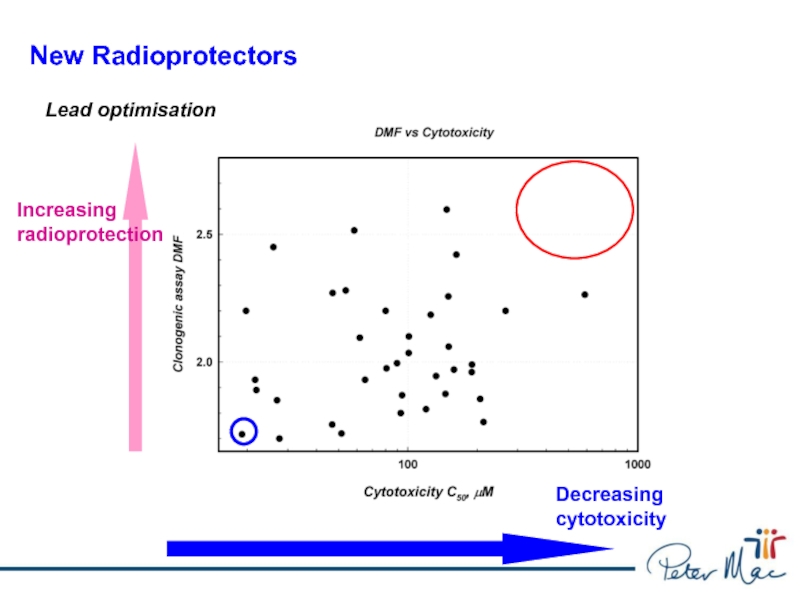
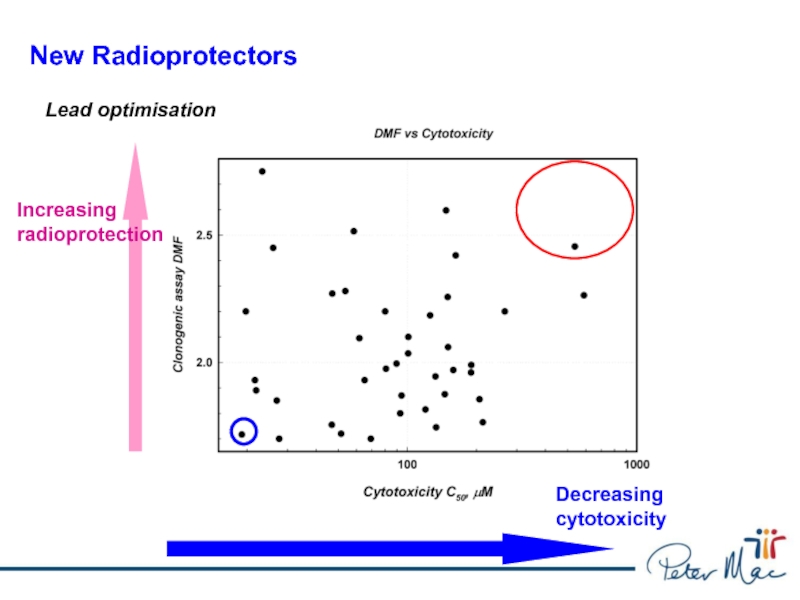
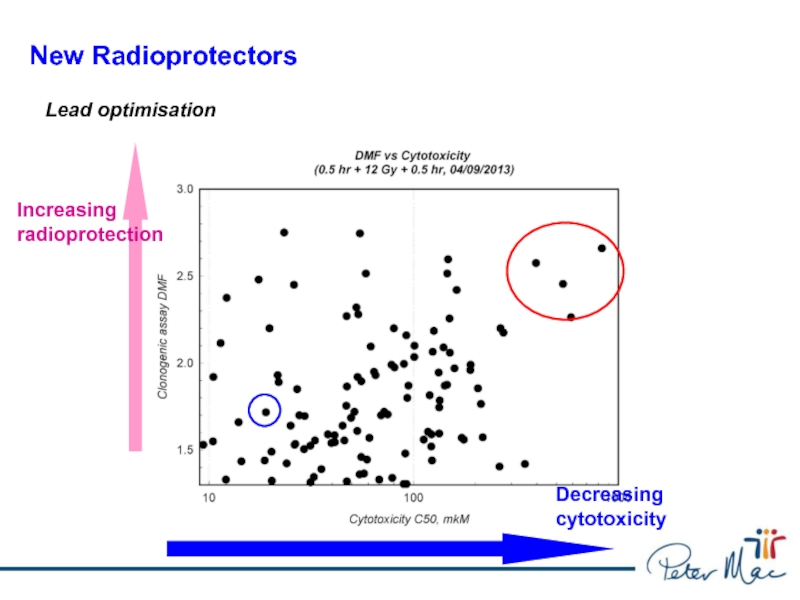

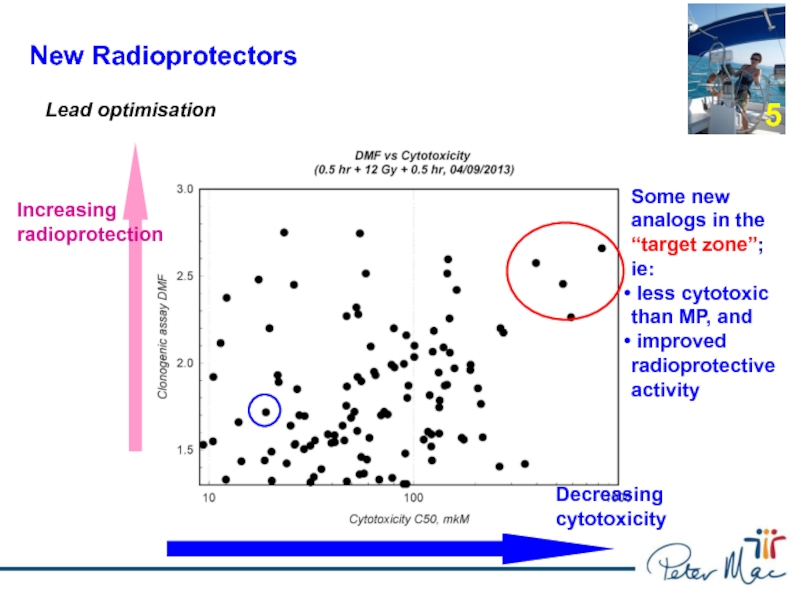

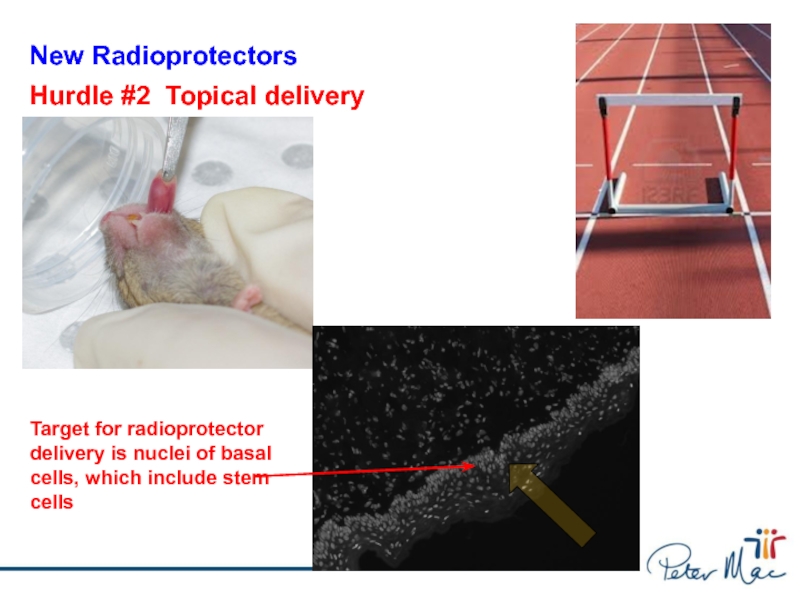
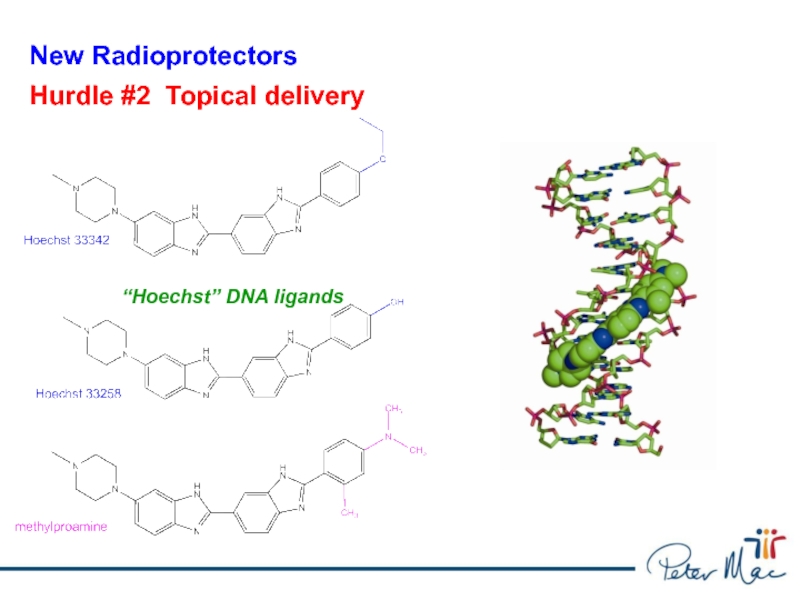
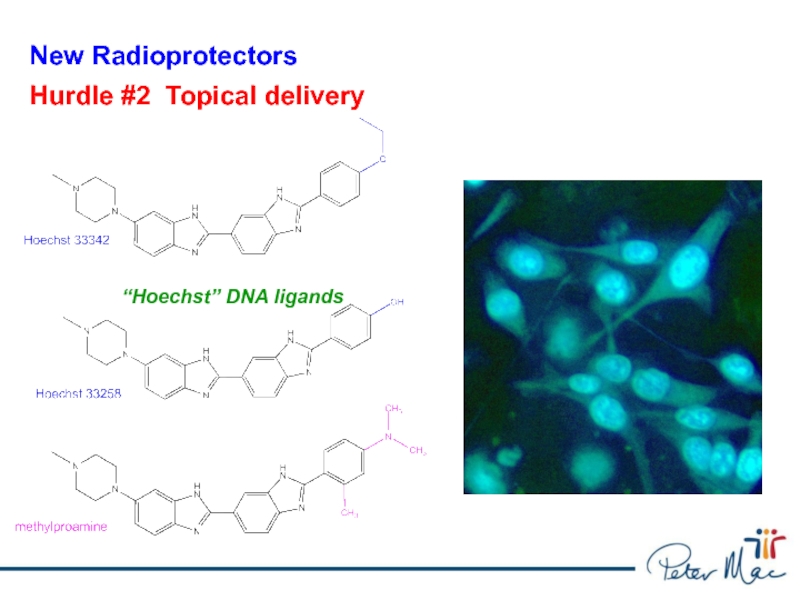
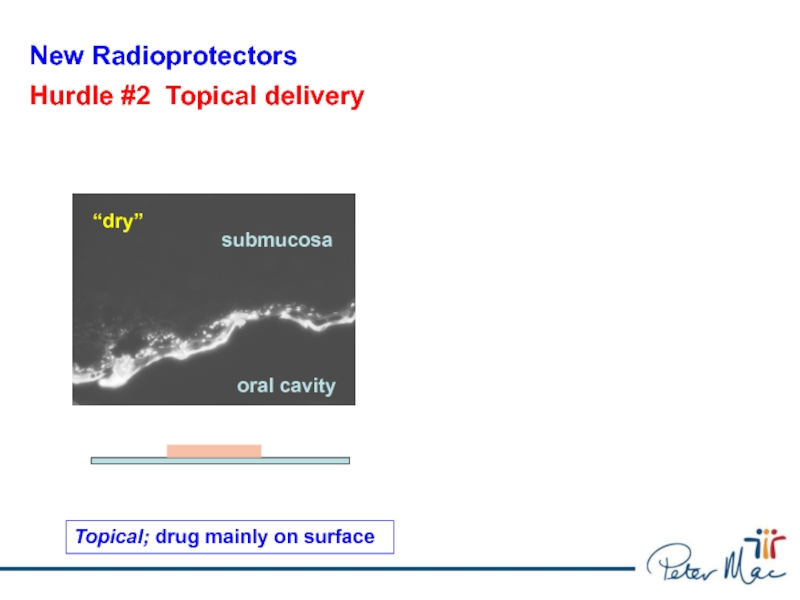
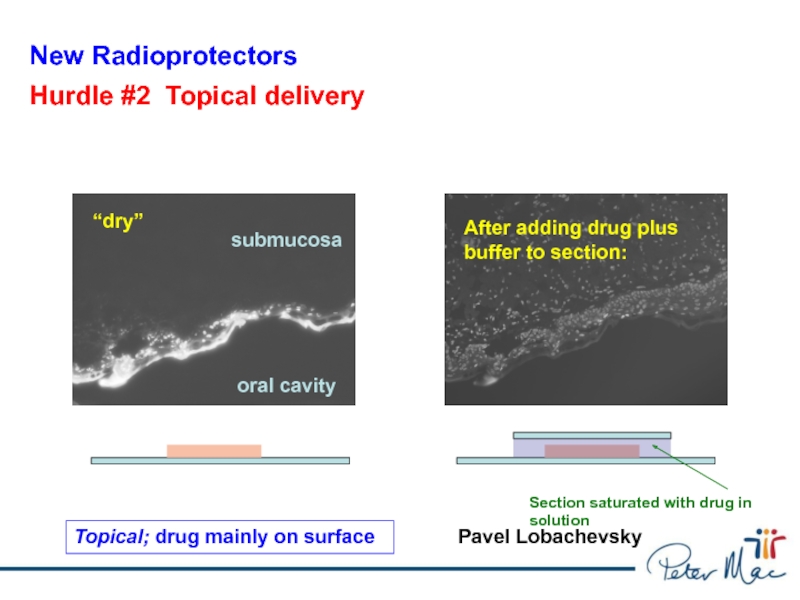
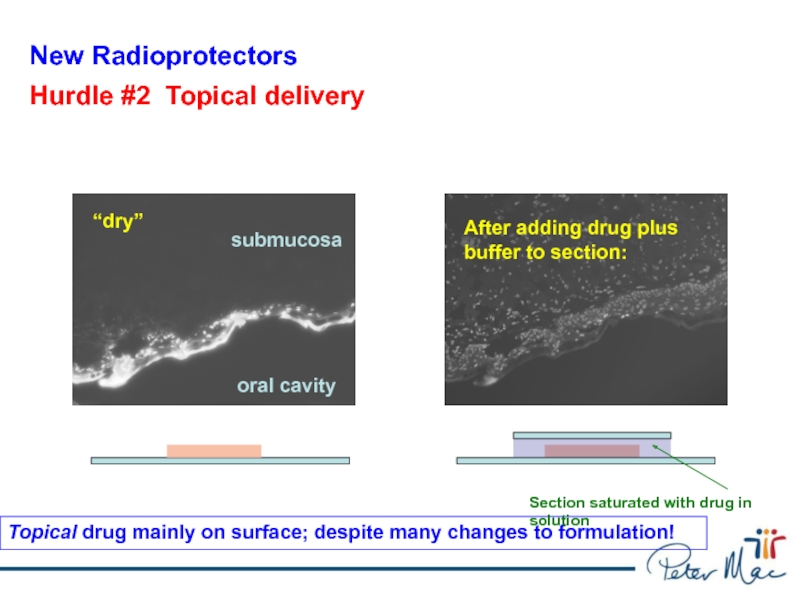

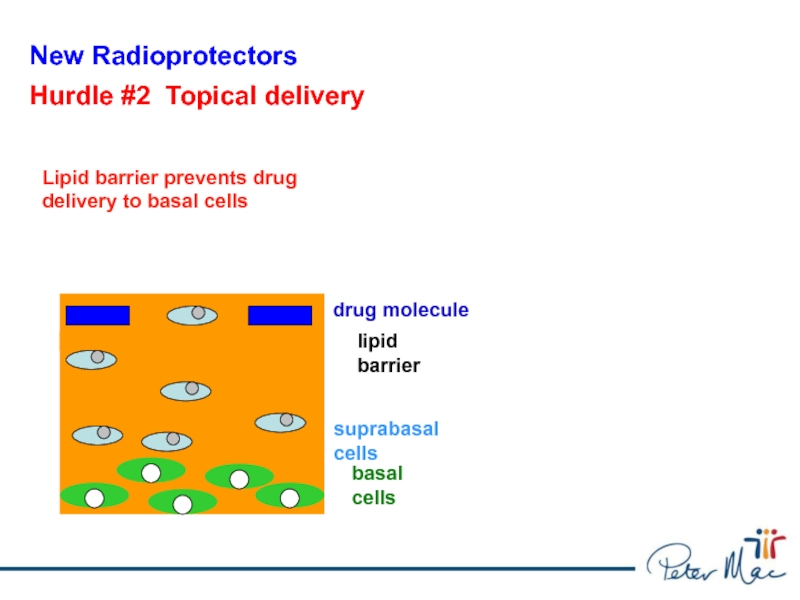




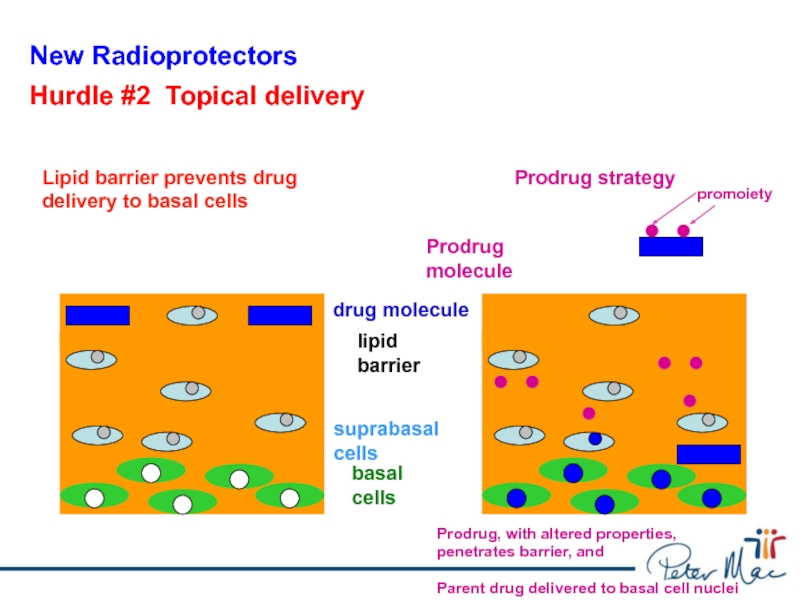
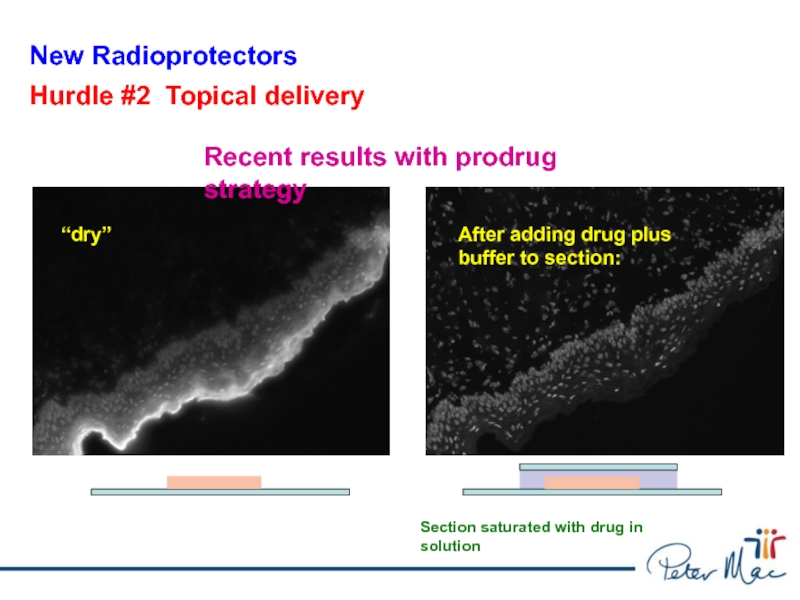
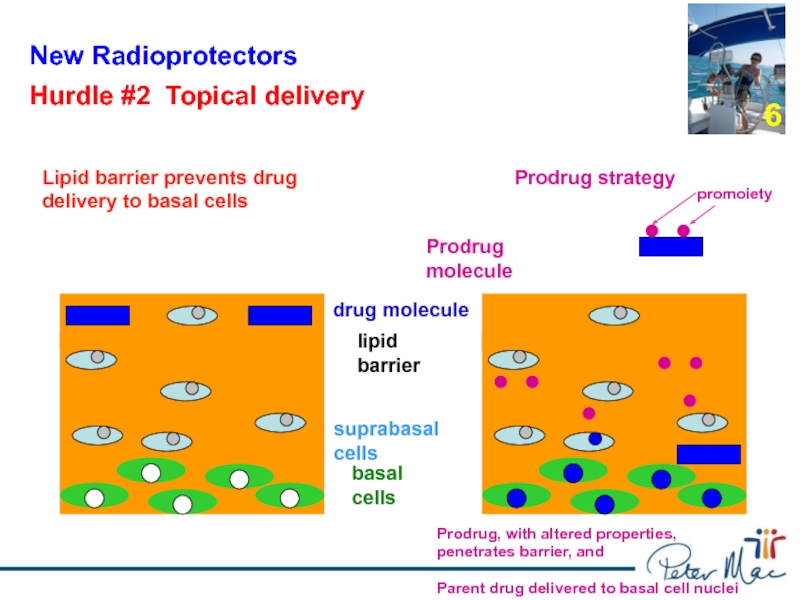

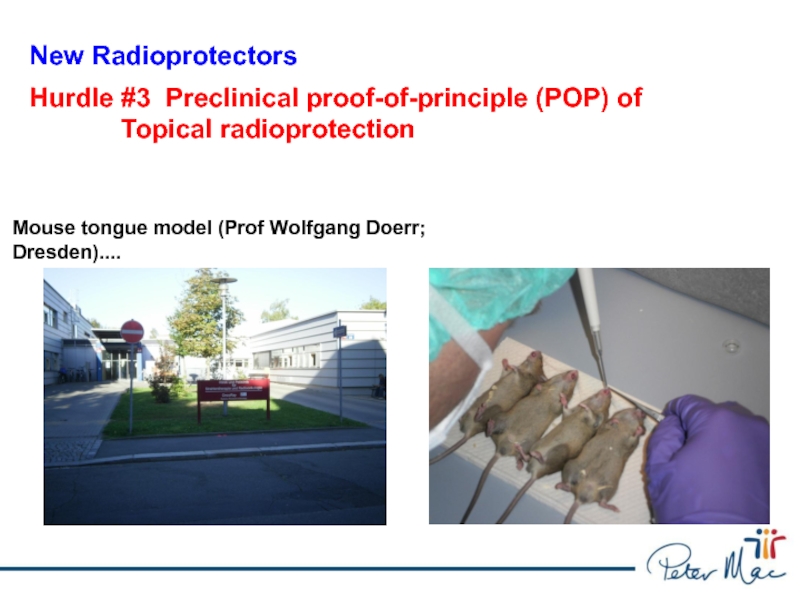
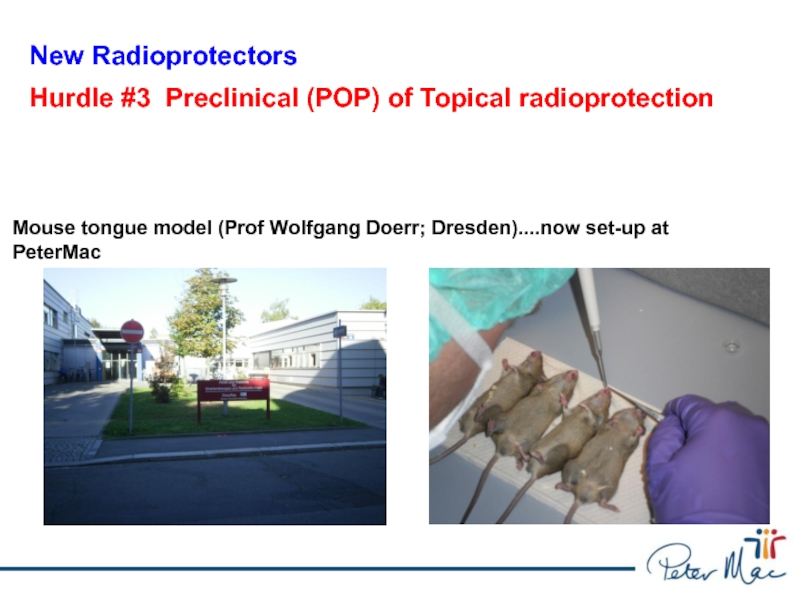


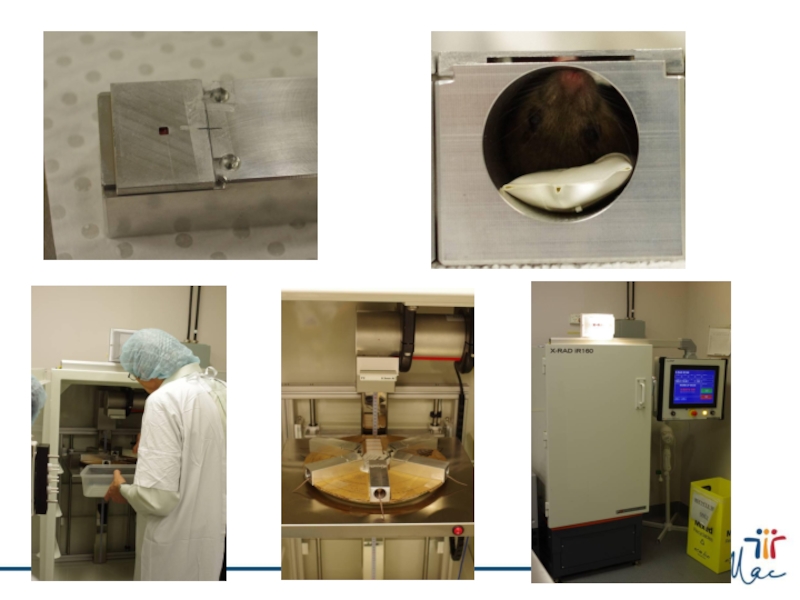

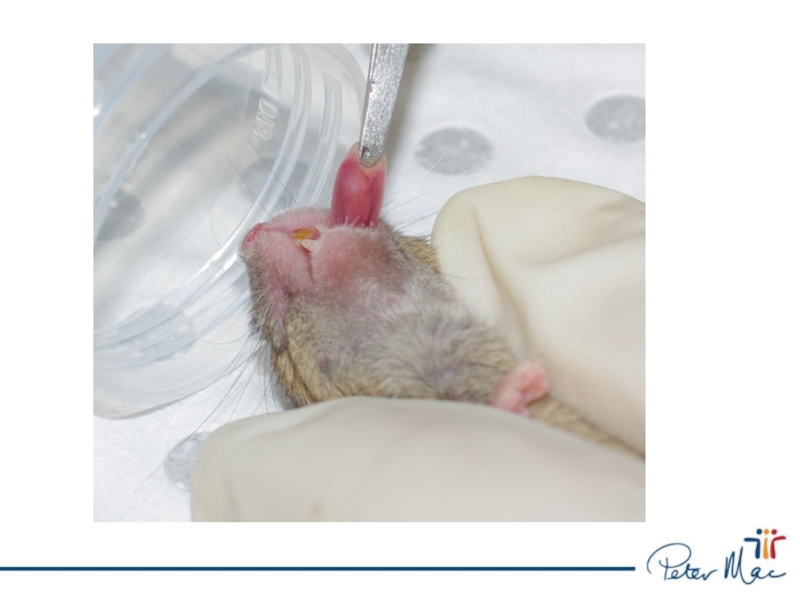
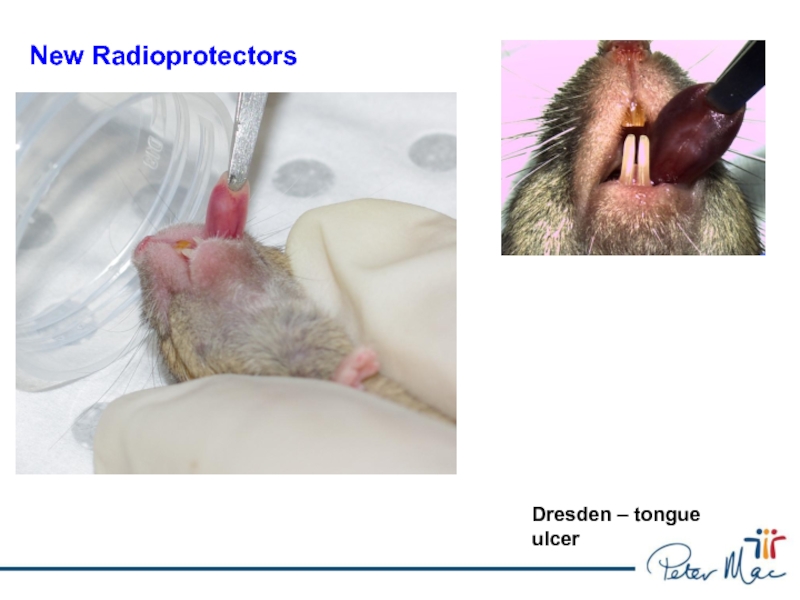
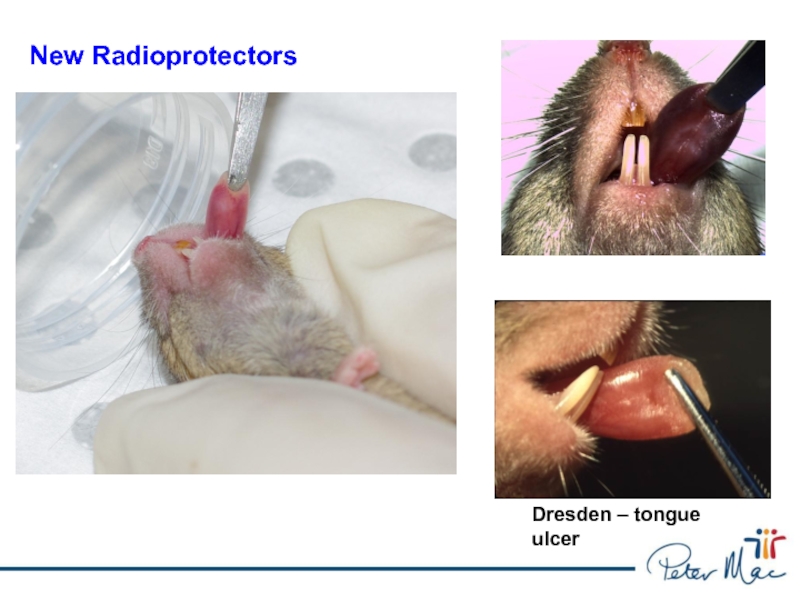
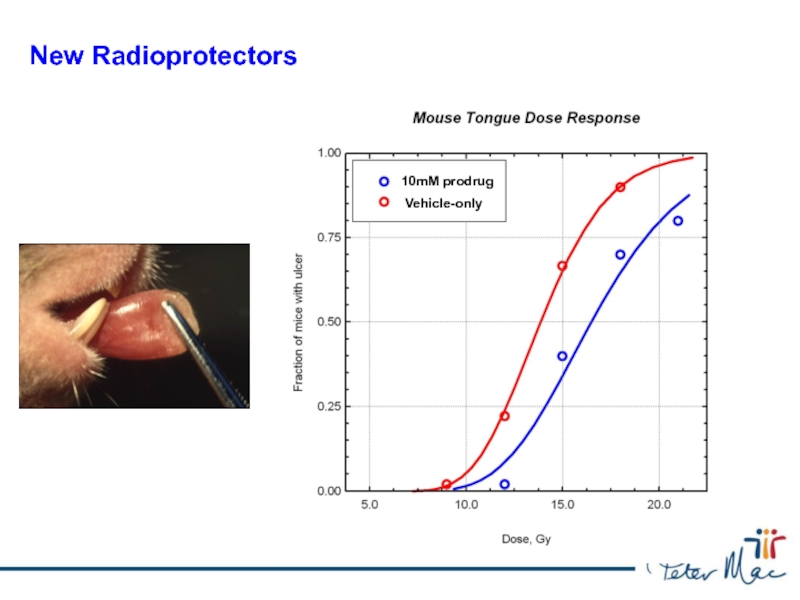

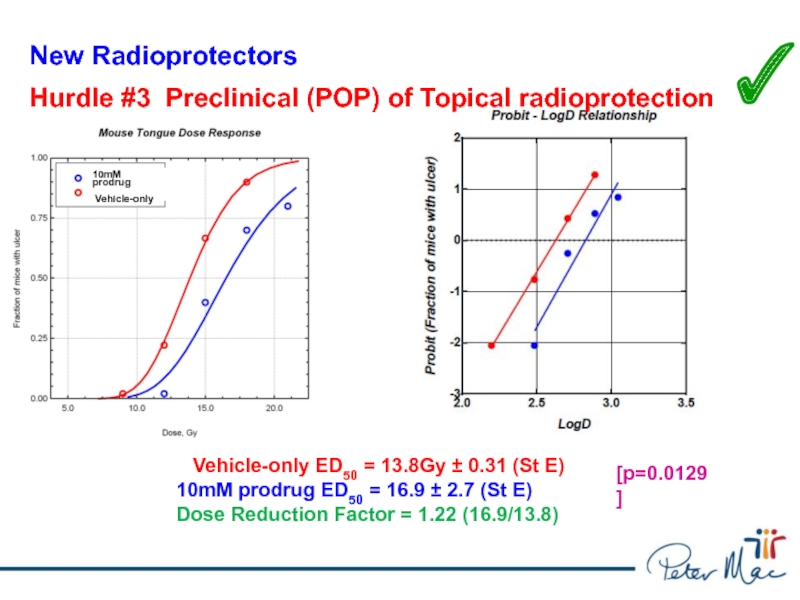
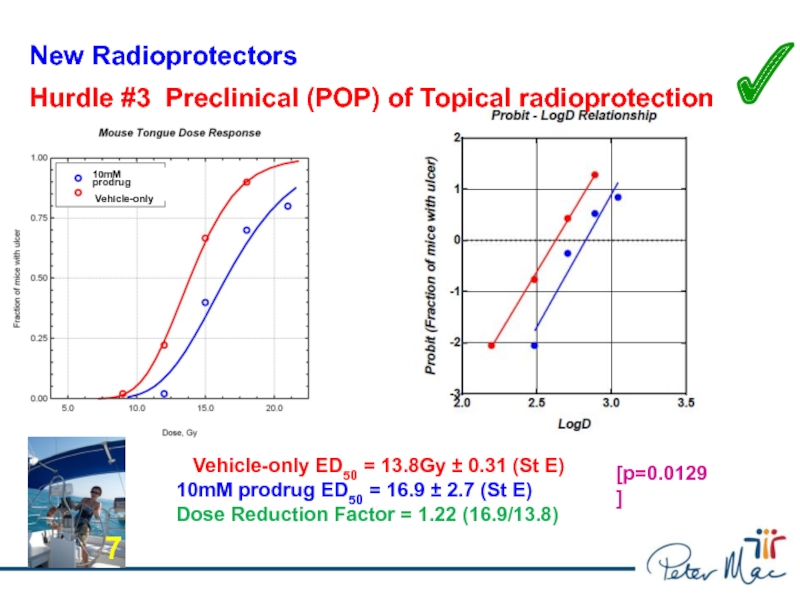
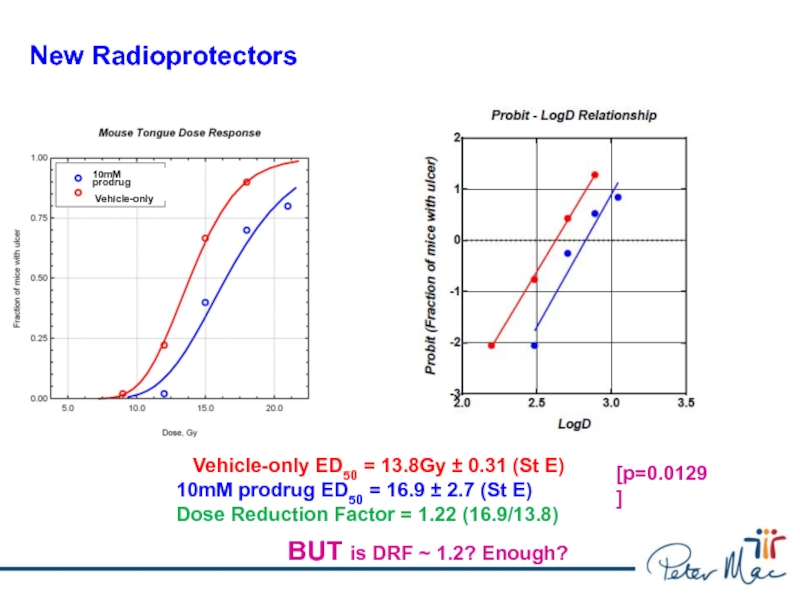

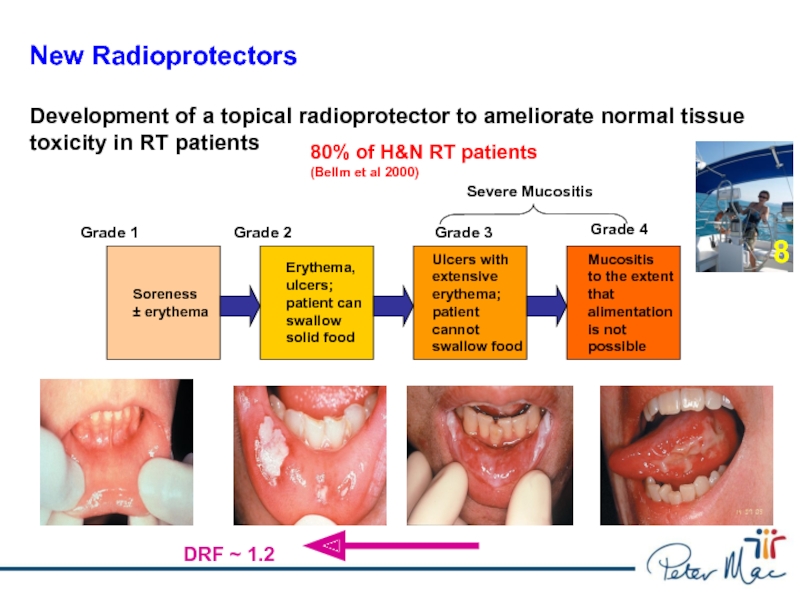
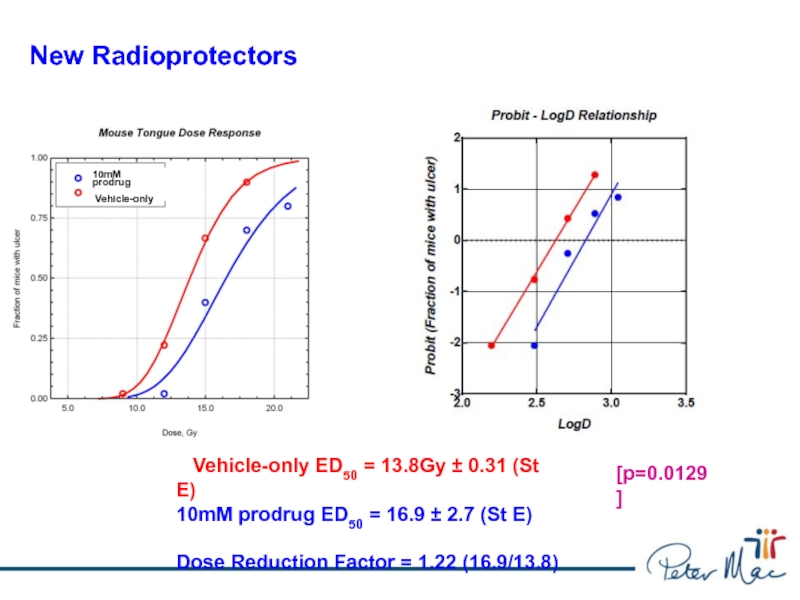
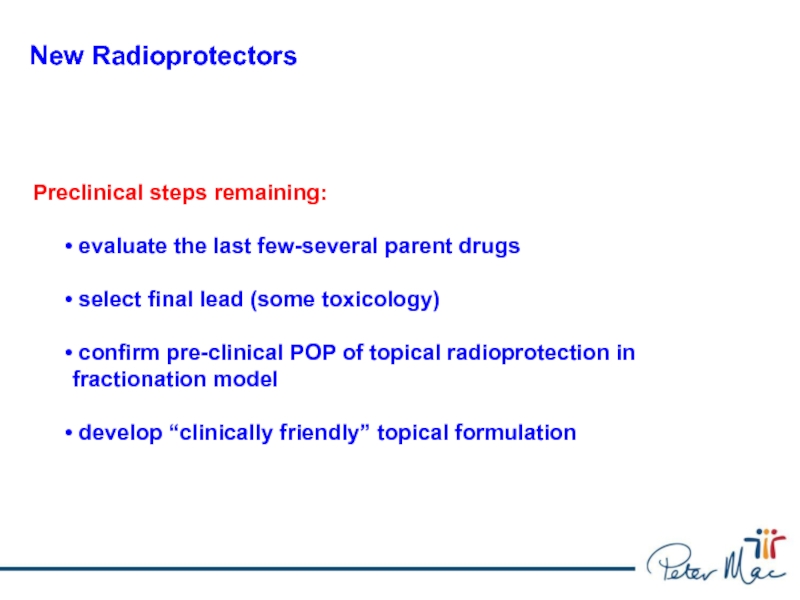

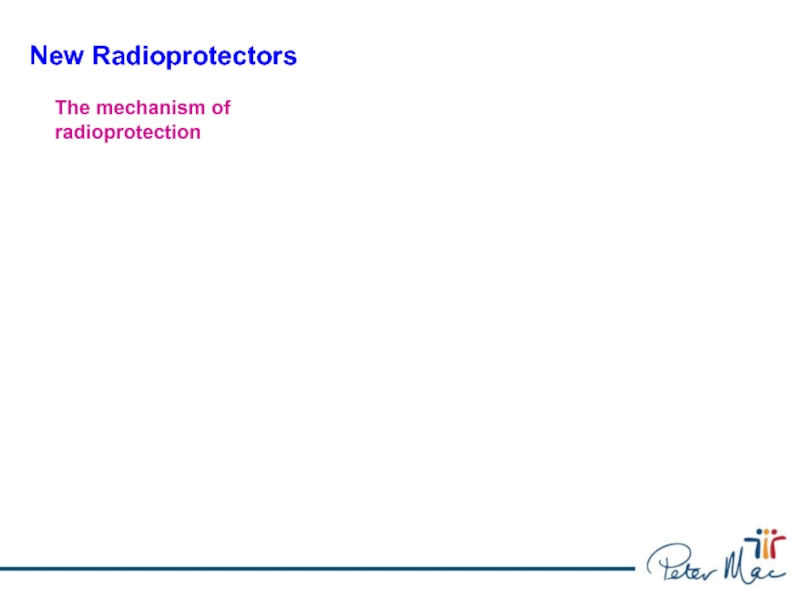


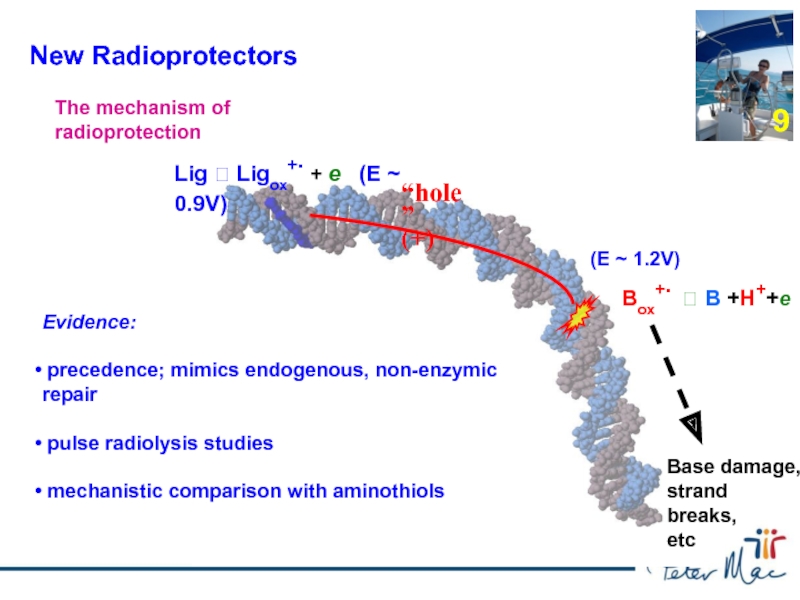
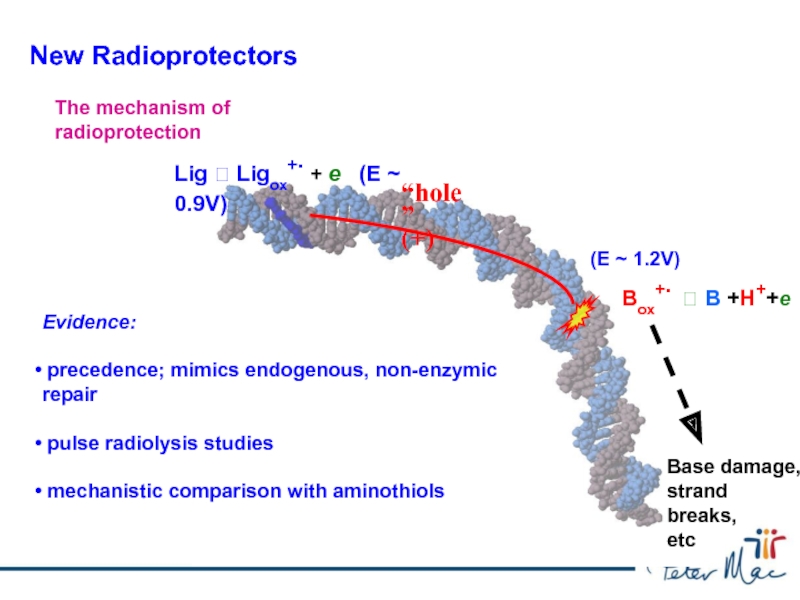
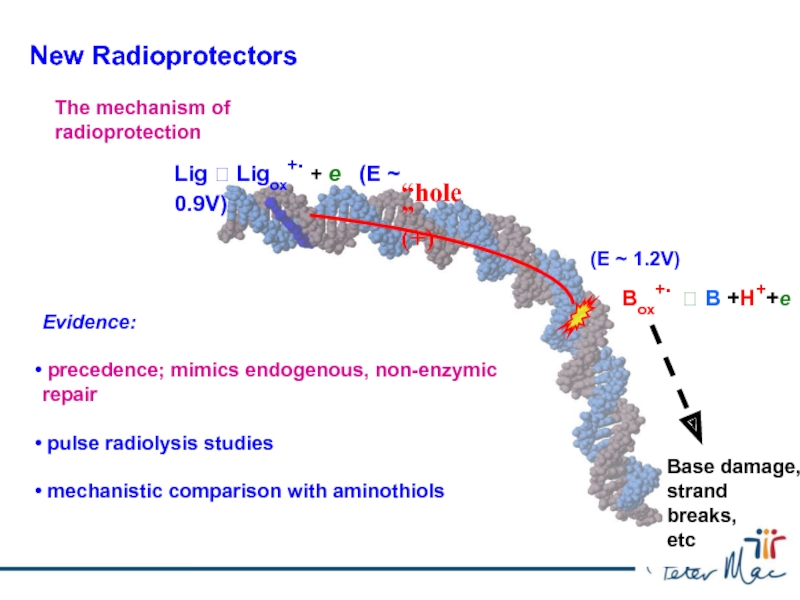

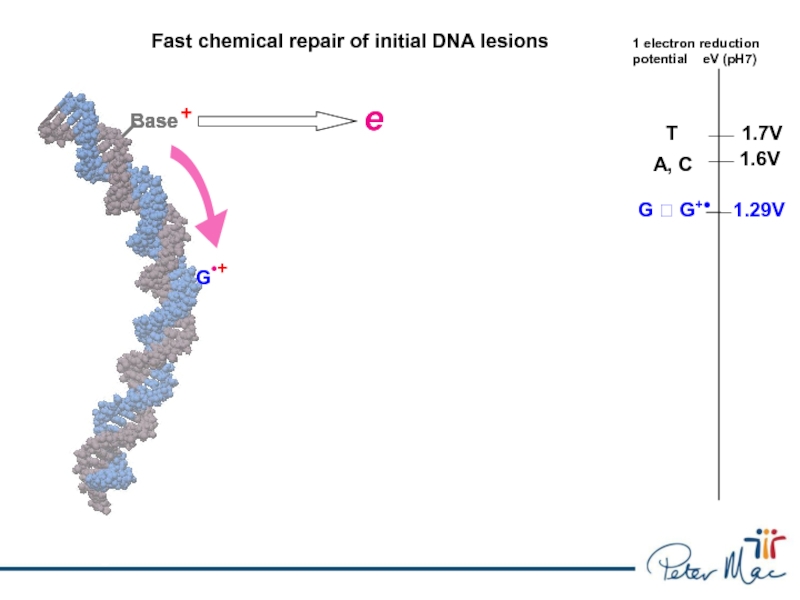

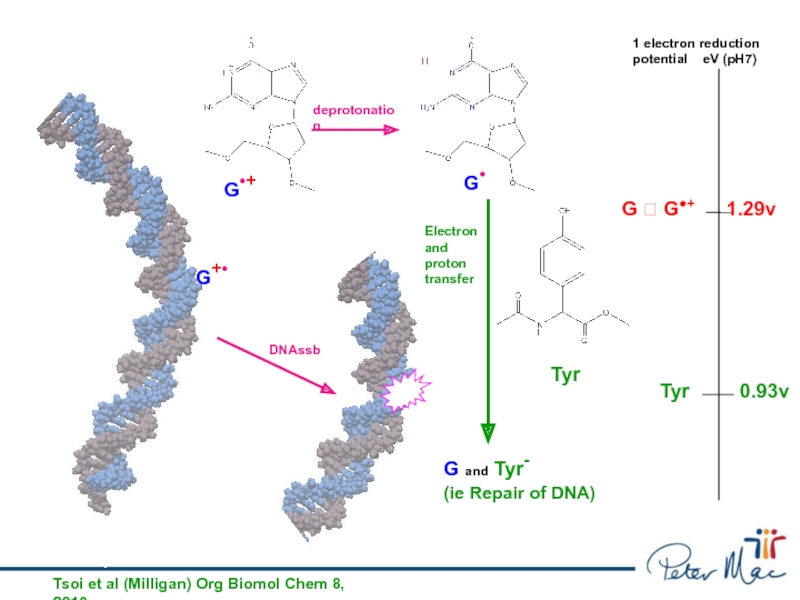
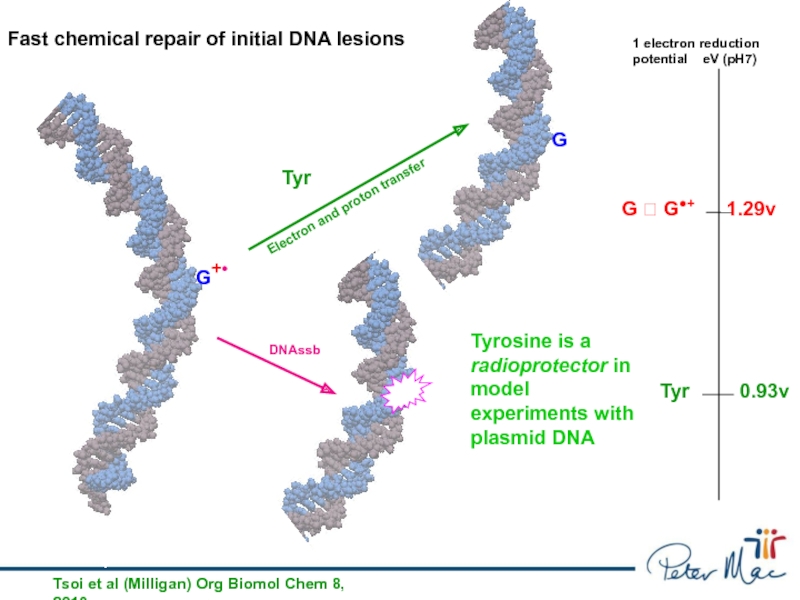
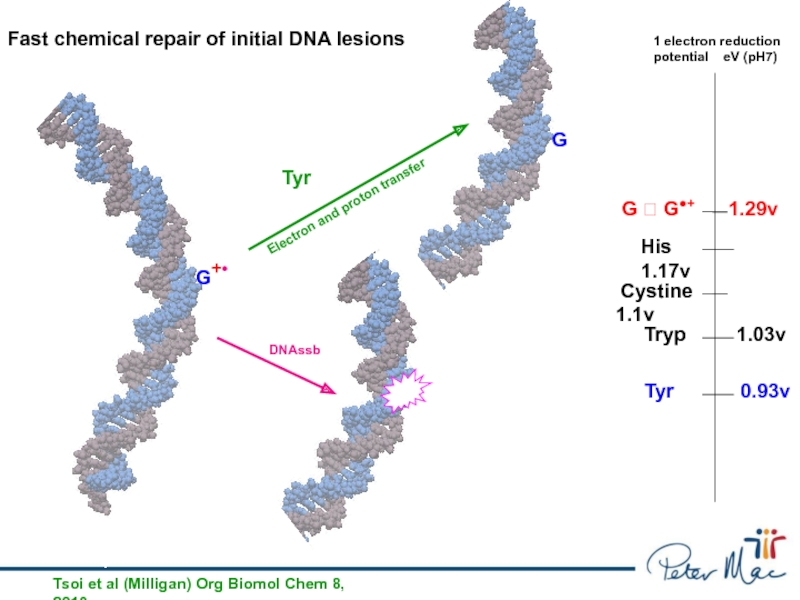

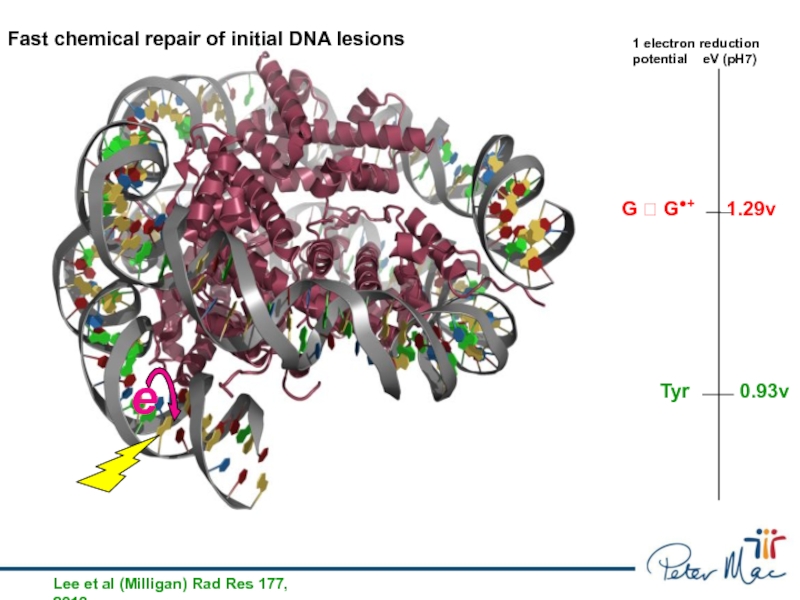
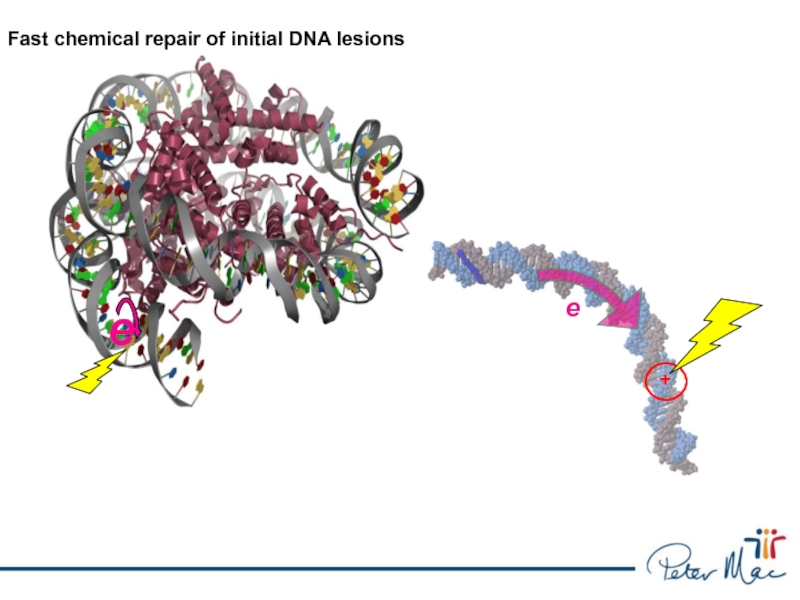
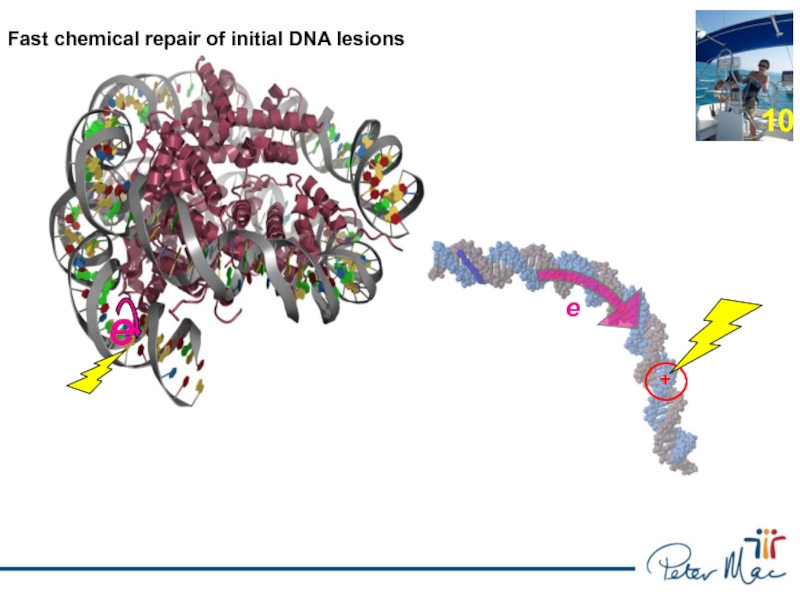
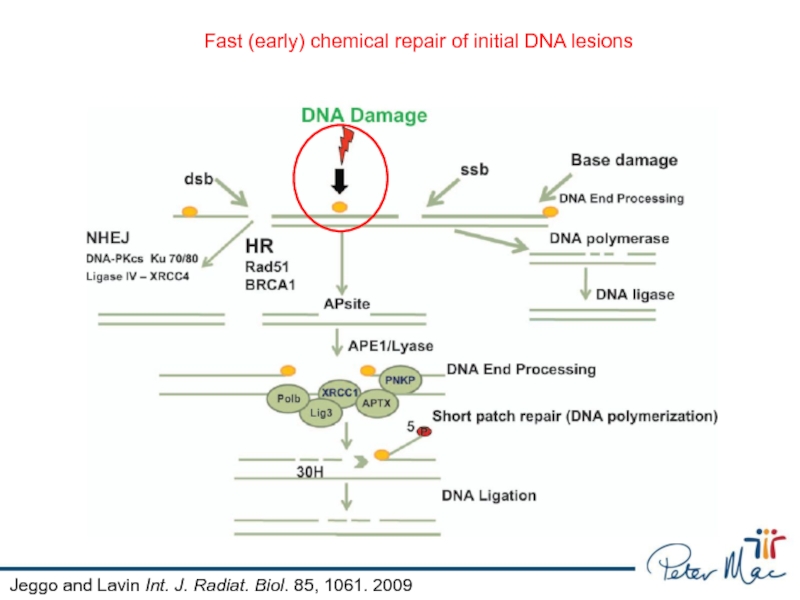
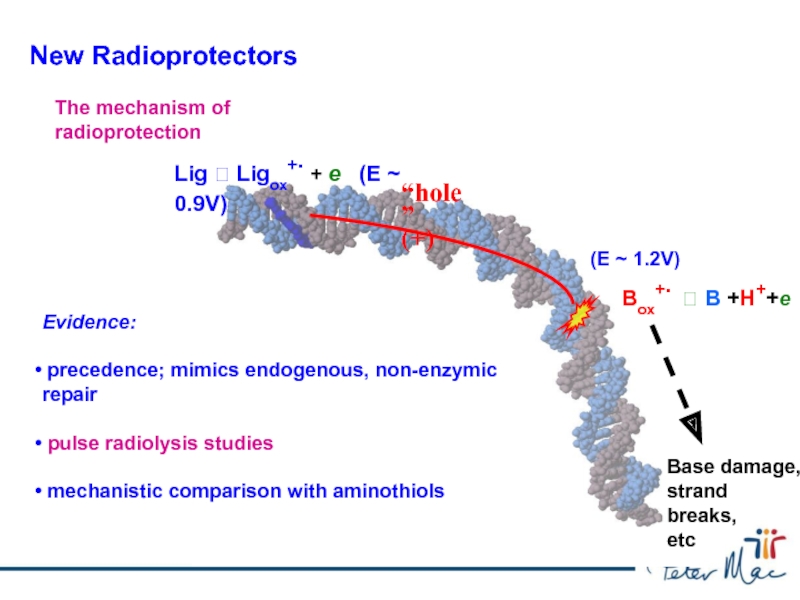
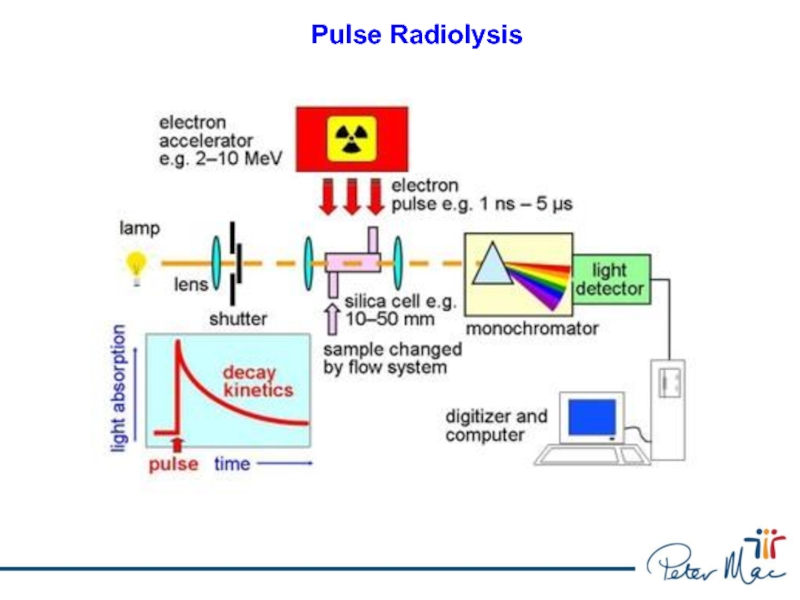

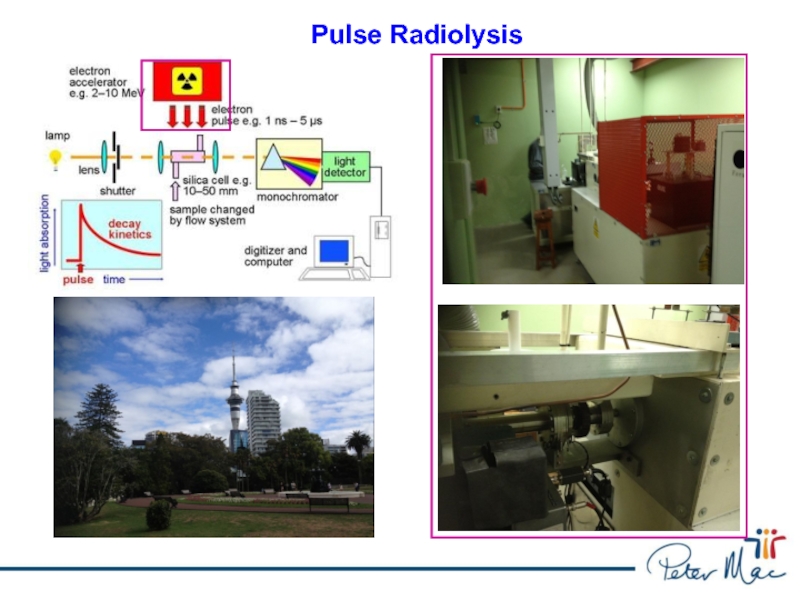
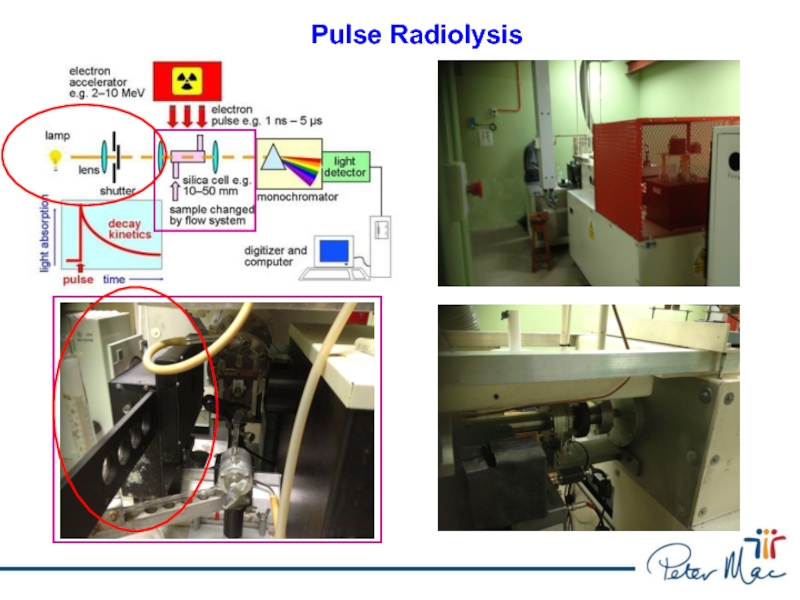
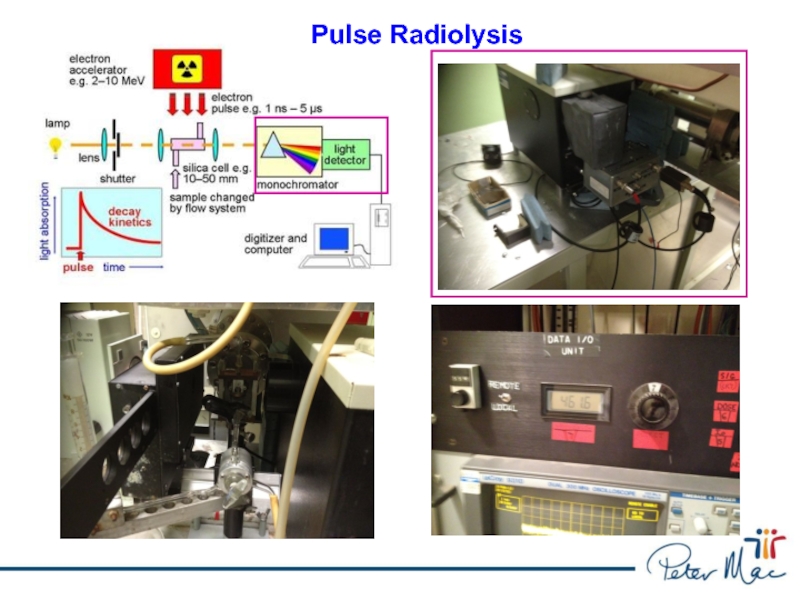

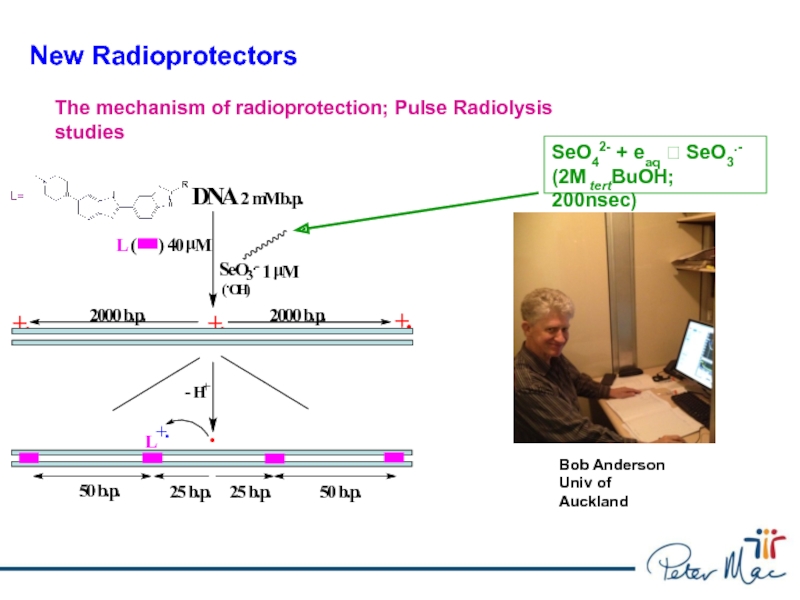
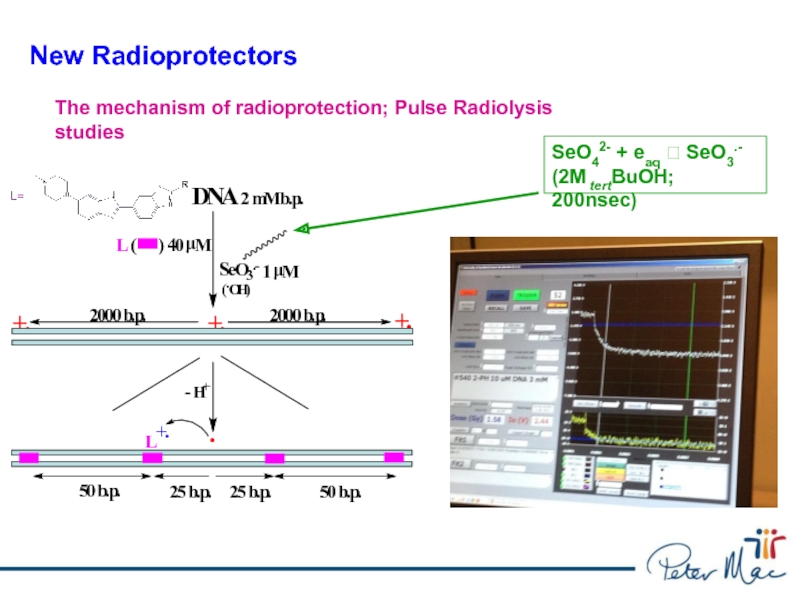
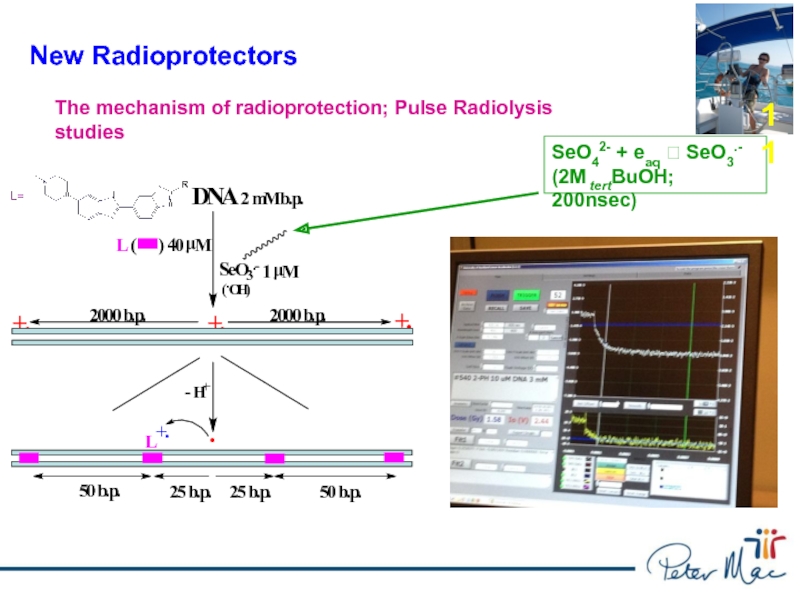

![ФЕДЕРАЛЬНОЕ ГОСУДАРСТВЕННОЕ
БЮДЖЕТНОЕ УЧРЕЖДЕНИЕ
МЕДИЦИНСКИЙ РАДИОЛОГИЧЕСКИЙ New RadioprotectorsThe mechanism of radioprotection; Pulse Radiolysis studies(OD/Gy) = a{1-(1-[ligand]/[DNA])2n+1} + b, New RadioprotectorsThe mechanism of radioprotection; Pulse Radiolysis studies(OD/Gy) = a{1-(1-[ligand]/[DNA])2n+1} + b,](/img/thumbs/e649fbe7e6afc716d22b67b08ec2116e-800x.jpg)
